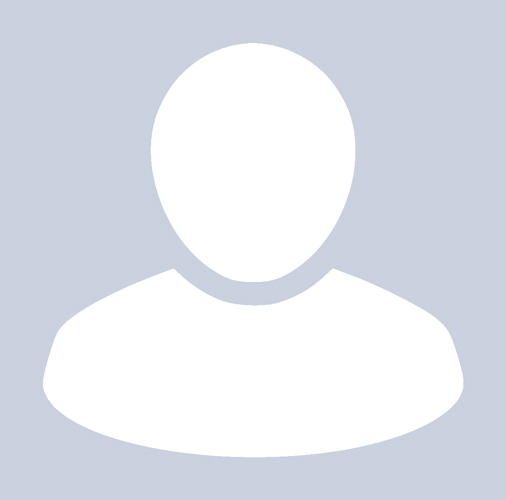 SOLOMON LUNGER
.
September 11, 2023
.
F100 Builders
SOLOMON LUNGER
.
September 11, 2023
.
F100 Builders
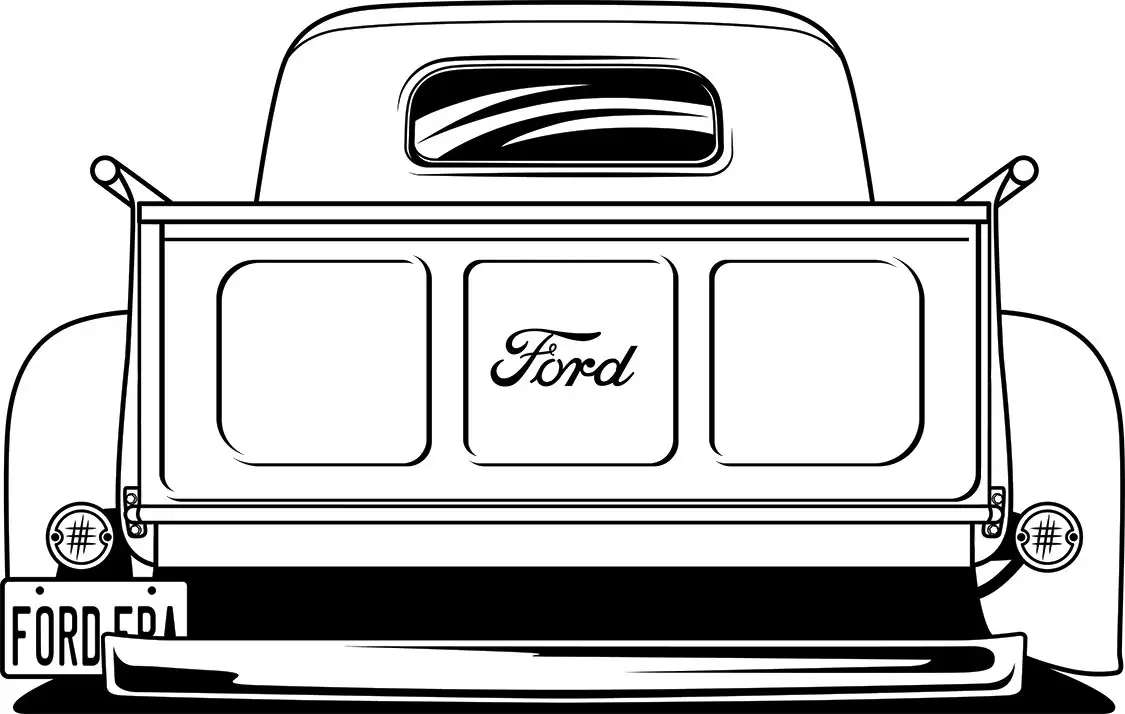
For more than 70 years, the Ford F-Series has represented the epitome of what it means to own and operate a pickup truck in the US. In 1903, Henry Ford built his first Ford truck. While some might argue that it was the vehicle that started the company’s pedigree of pickups that would eventually lead the market, that’s not necessarily the case. A few years later, Ford created the Model A with a service truck body, and a Model TT with a longer chassis and flat bed. Then came the Model T Runabout, supplied with a pickup body, which the Ford Motor Company officially recognizes as its first mass-produced truck (debuted in early 1925).
FoMoCo would go on to design and construct a slew of pickup truck models with great success from that point on, you can look back and see that prior to the release of the F-Series, trucks were merely a means to haul things around. It wasn’t until the F-Series debuted in 1948 that Ford really began to focus on truck models and functions leading to a lineage of pickups that would dominate the truck market.
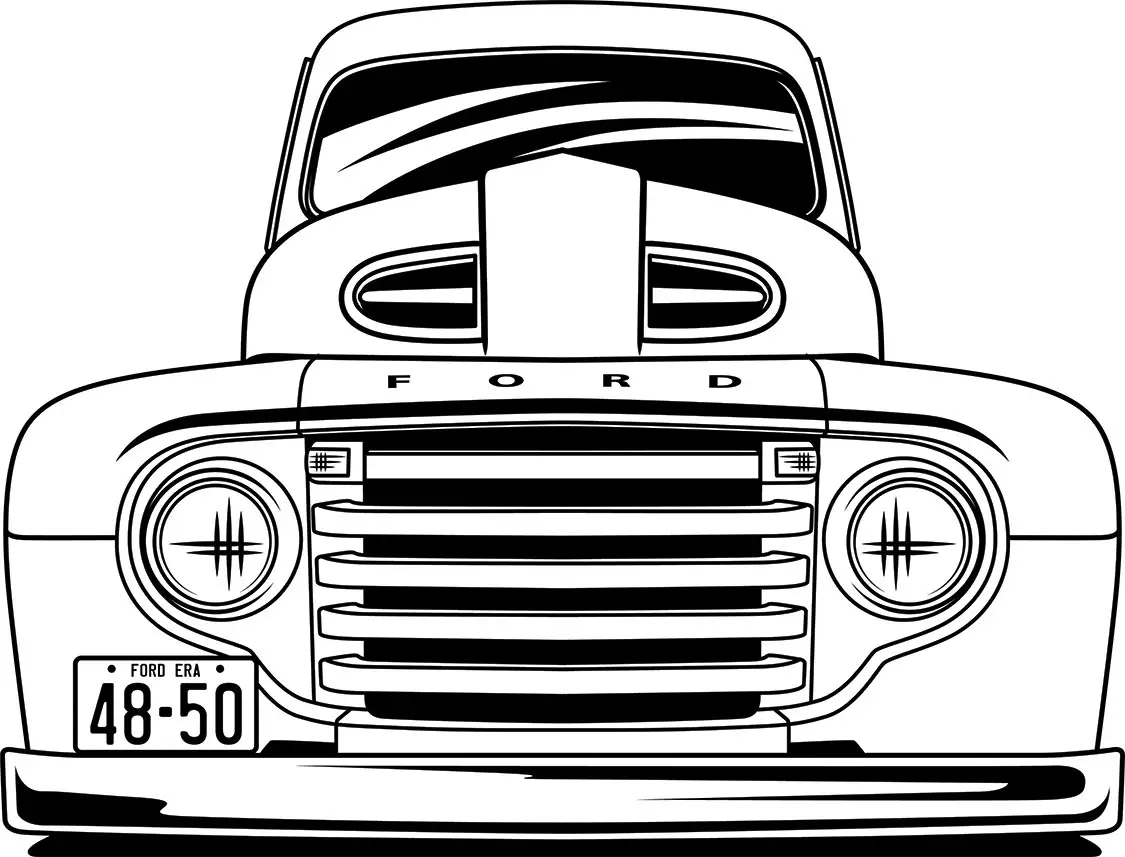
In 1948, America was booming. The war was over, and the combined war effort put millions of Americans to work, boosting production across many industries. With that boom came innovation in truck design and implementation. What if pickup trucks, previously made for commercial fleets and farmers, could be made accessible to regular average Americans with a need for a utility vehicle with daily driver comforts? Thus, the F-Series was born.
Prior to the F1, no real attention was given to safety, handling, styling, driving comfort, fuel economy and other necessities as a “family” vehicle. Once the F1 debuted, the real turning point in Fords truck history came to fruition. At that time, Ford was the first manufacturer to see trucks a bit differently, playing around with many designs and ideas that would eventually change the way people looked at and used the pickup truck.

We are going to take a look at the first six generations of the F-Series, 1948-1979.
Kicking it off is the 1948-52 Ford F1. After World War II, it took a bit of time before the passenger cars and trucks were put back on the production line and made available to the public again. By the time Ford was able to get back into truck production, it was making the same truck from 42-47.
The company was determined, however, to make a complete redesign that would not only be marketed to the farmers and fleet companies, but to a much wider audience. So, in November 1947, the first F-Series pickup rolled off the assembly line in Highland Park, Michigan.
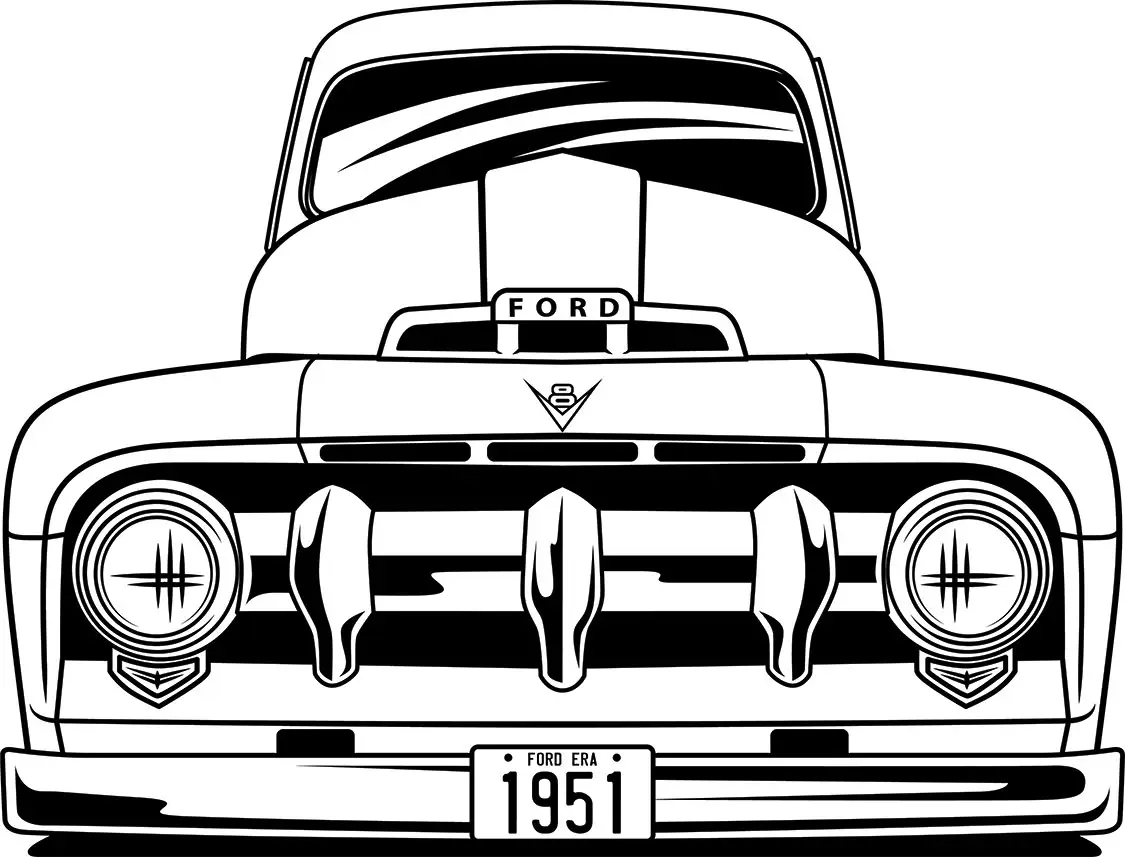
Then on Jan. 16,1948, Ford announced its newly designed Ford F1 pickup truck. The new F1 was built on a 114-inch wheelbase. Compared to the previous model, the new F1’s cab was 7 inches wider and provided more headroom. The front fenders were also wider, taller and designed to look like a single piece that wrapped around the front. The rear fenders were no longer teardrop shaped. Instead they were more rounded and continued the side body lines of the truck from the front all the way to the rear. Previous models had a vertical grille, but the new F1 was distinctly different with a wider five-bar horizontal grille, with the turn signals integrated into the top grille bar.
The familiar long, pointed hood connected the F1 to the lineage of trucks up to this point, but it now incorporated bold Ford lettering at the nose, with two openings above it. The sides of the hood still had a long vent, but now featured two chromed bars and the Ford logo in block lettering. The doors on the ’48 were moved forward 3 inches, making it easier to get in and out of the cab. Ford also added vent windows to the F1, which was part of the truck’s three-way ventilation system that consisted of the two vent windows and an added cowl vent.
The ‘50s were perhaps the most nostalgic time for the F-100 pickup, as this type of styling would never be used or seen again but had defi nitely made an everlasting impression.
All the improvements Ford made to the new cab were based on careful design and development. The company called it the “Million Dollar Cab,” which reflected the amount that Ford had spent on research and tooling.
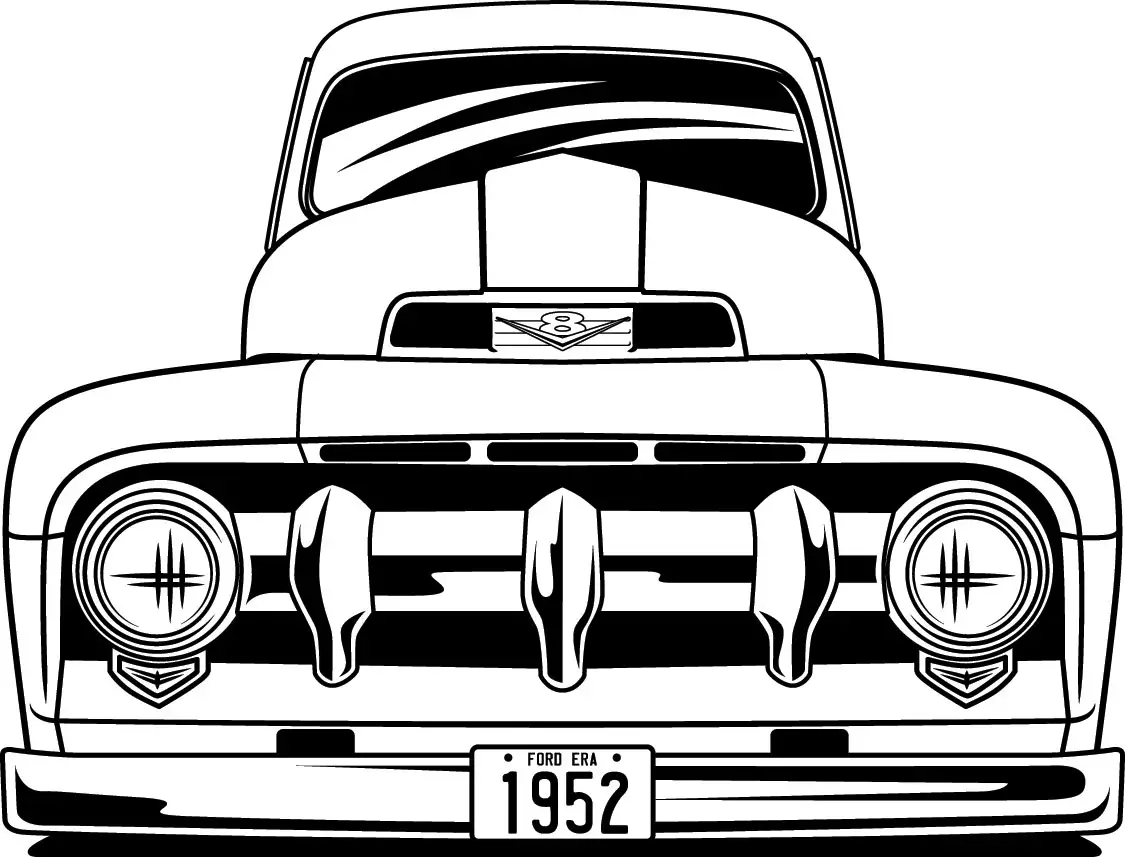
The years 1948-50 saw very few body changes. After three years of production, the F1 needed a facelift and it got it in 1951. The most noticeable changes came at the front of the truck, which now had a wide, single-bar front grille. The big grille bar stretched across the entire face of the truck, and it had three large, evenly spaced supports. Protruding headlights were mounted on each end of the grille with the turn signals mounted underneath. For the 1952 Model year, with truck sales declining, Ford began working on redesigning its F1 1/2-ton pickup. But still had to get through the 1952 model year.
The body of the 1952 F1 remained virtually the same, except for a few trim changes. The nose vent trim around the front of the hood was now painted. The Ford lettering moved to the panel above the grille and was now chrome block letters. The vent trim spear on the sides of the hood now incorporated the F1 designation in a circle at the front, and a small insignia at the center of the hood/nose molding indicated that the truck was equipped with the 6 cylinder or V-8.
The second generation of Ford’s F-Series light-duty trucks started with Ford’s 50th anniversary and ended with one of the most popular trucks that collectors and Ford truck enthusiasts think of when you mention the word “F-100.”
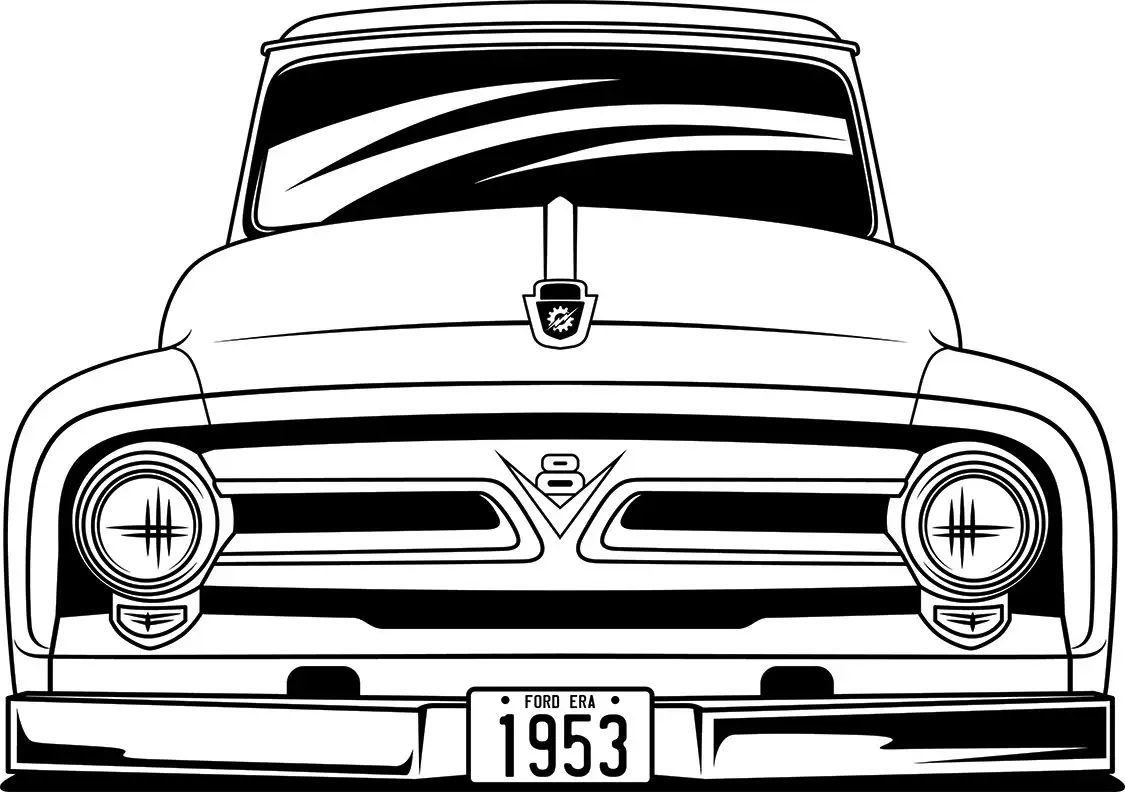
The ’50s were perhaps the most nostalgic time for the F-100 pickup, as this type of styling would never be used or seen again but had definitely made an everlasting impression. One of the most notable upgrades to the ’53 F-Series truck was the change to the F-100 designation. It’s not official as to why the truck’s nomenclature was changed from F1 to F-100, but the popular belief is that it was influenced by the US Air Force’s first supersonic fighter jet, the F-100 Super Sabre. The Korean war had just ended, and Americans were focused on getting back into working toward the prosperity they had after World War II. So, naming a new, sleek and completely redesigned truck after the fighter jet seems quite plausible.
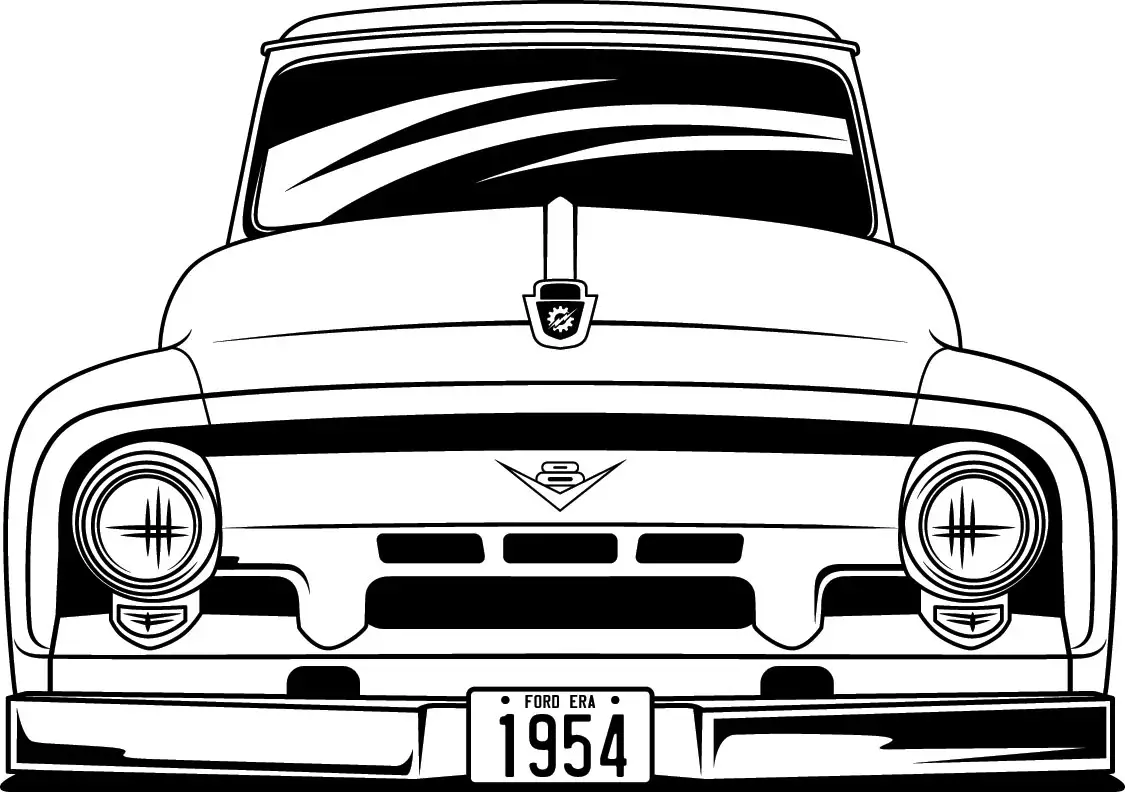
Just like the innovative, streamlined jet planes, Ford made the ’53 sleeker and more aerodynamic than previous models. It now featured a longer hood with more curves, and the front portion blended in and became a part of the fenders. Designers did away with the large single-bar grille and added a double-bar grille that also incorporated an engine designation logo in the center. Ford did away with the flat windshield and added a larger, curved windshield to the truck. The new glass had more than 400 square inches of area. Because the new windshield was raked back at the top, it slightly changed the roofline of the truck. The use of a larger rear window helped change the trucks overall appearance. With a 2-inch-lower windowsill, the ’53 had a more open cab design with a 55 percent increase in total glass area.
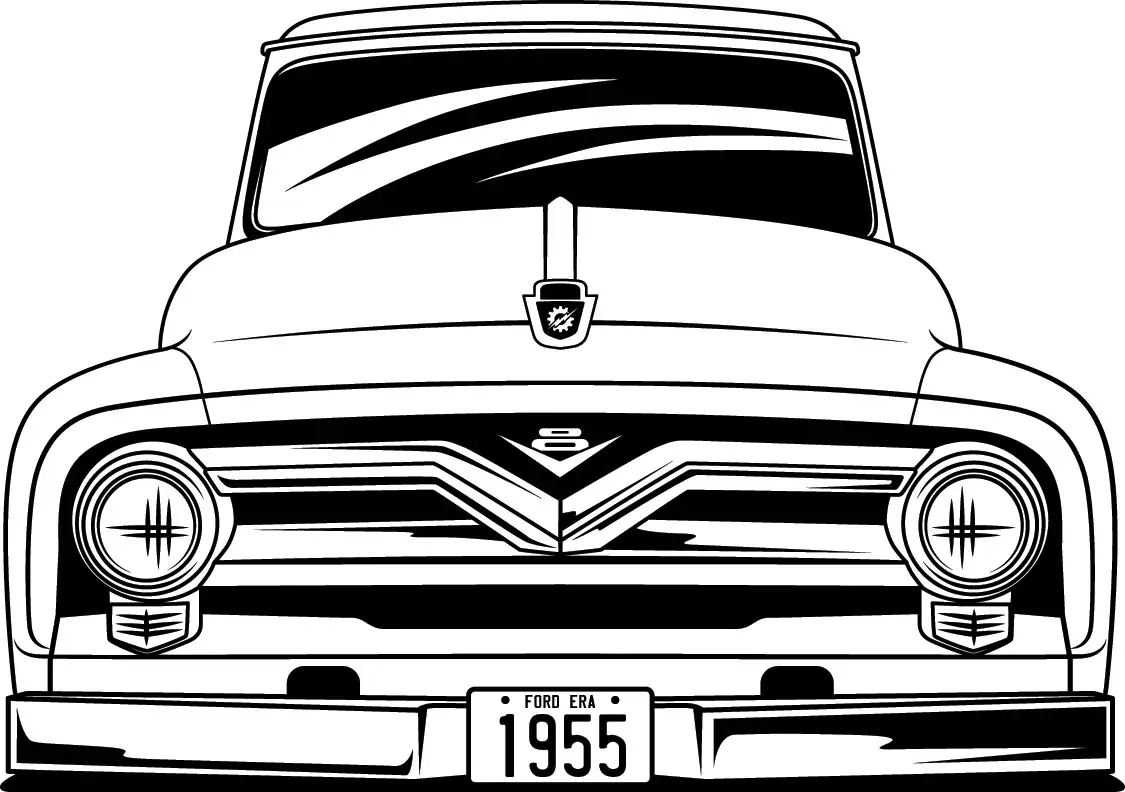
The big news for the F-100 in 1954 was the introduction of the Y-Block V-8 engine that produced 130 hp. Not much else changed in the trucks overall exterior design from the previous year. A new grille was slanted forward slightly and had three air openings underneath the center logo. All V-8 equipped trucks had the same emblem, while the Deluxe cab models featured three chevrons on each side.
The mid-’50s brought in a whole new era for the automobile as part of the American lifestyle. Vehicle designs of the time resulted in more classics that are worth 100 times their original value today. While the cars got all the design attention, trucks such as the F-100 were beginning to make some style changes of their own. But unfortunately, it didn’t really begin until after the release of the ’55 models.
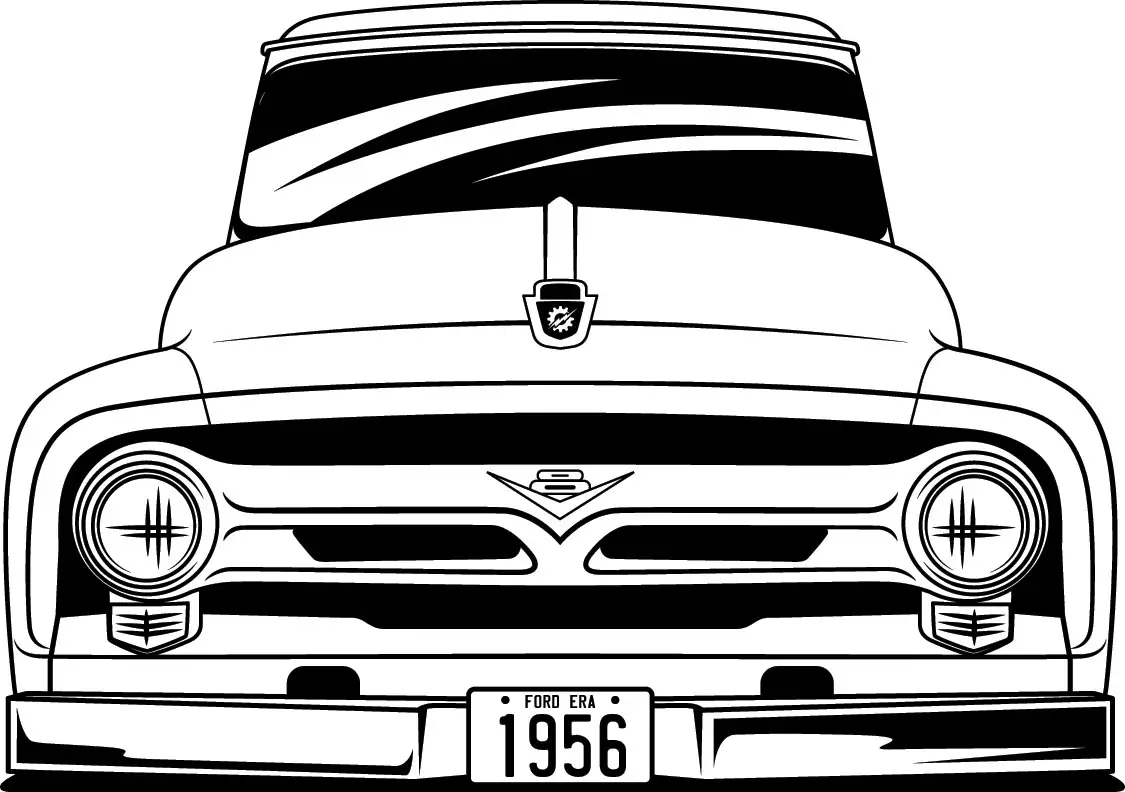
Ford only made a few minor changes to the ’55 F-100. The most noticeable was the new V-shaped grille, which consisted of the vertical bars with a dropped V in the upper bar. The engine designation emblems remained the same with the V-8s and the four-point star. But because the emblems were located above the dropped-V grille, they were a more dominant design feature making it appear as if they were floating in front of the truck. Along with the new grille, Ford also changed the side emblem with a chrome circle that has the F-100 lettering inside.
Speak with any Ford F-100 truck owner or enthusiast, and the topic of the ’56 “Big Window” will almost always enter the conversation. Ford’s design change of adding a large, full-wrap windshield with vertical door pillars made a huge impact on the truck’s popularity. In fact, “Big Window” pickups are still admired and sought after today as the more desirable and collectible models.
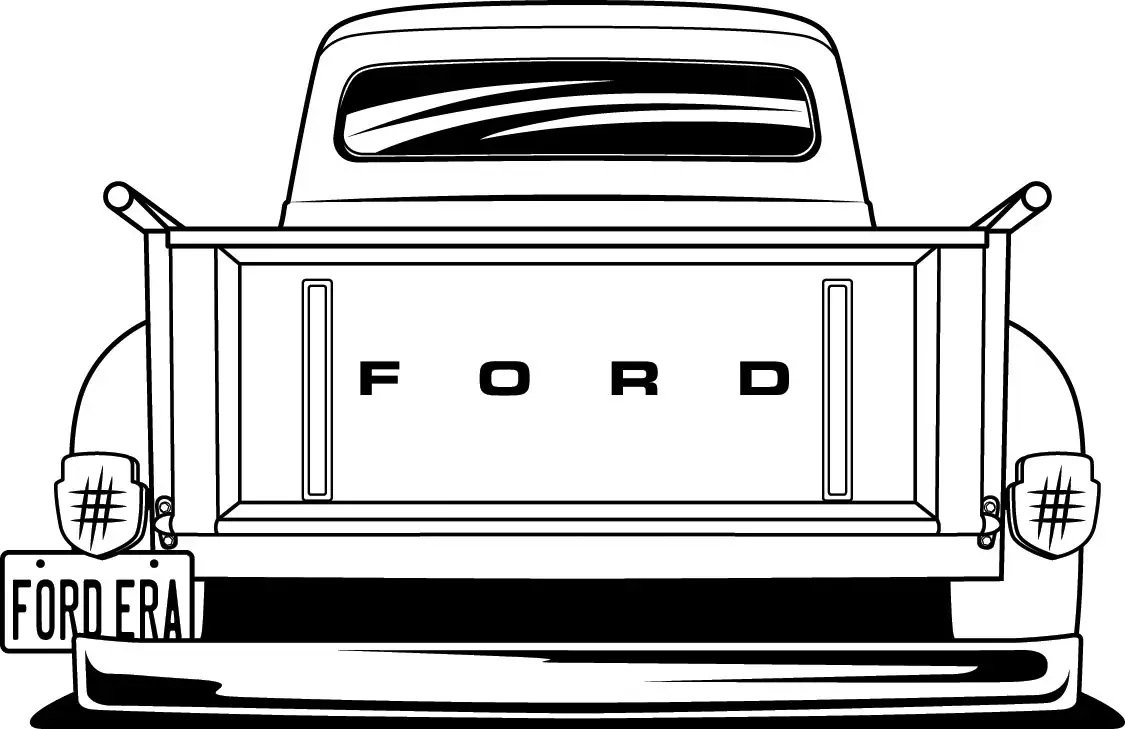
But the “Big Window” nickname wasn’t given to all the F-100s. Some models featured an optional larger rear window that was almost the same size as the front windshield. The style of the cab was definitely a big change, which was further accented with the roof’s new styling, now featuring a visor above the front windshield. The headlamps also had a slight visor over them, but the rest of the truck’s body didn’t have too many other changes from the ’55 models. The front grille was also the same for the V-8s, But the 6 cylinders no longer had the star or any designation on the front. The side emblem was changed to have the F-100 in a red circle over a chromed spear with the Ford lettering in red.
The third gen brought with it the introduction of the “Styleside” pickup. This style would forever set the trend for what a truck bed should be. To this day, the flat bedsides of this generation’s Styleside model make up the preferred truck bed, and at the time they provided a host of unique characteristics that not only included more space, but an exterior appearance that was much more streamlined.
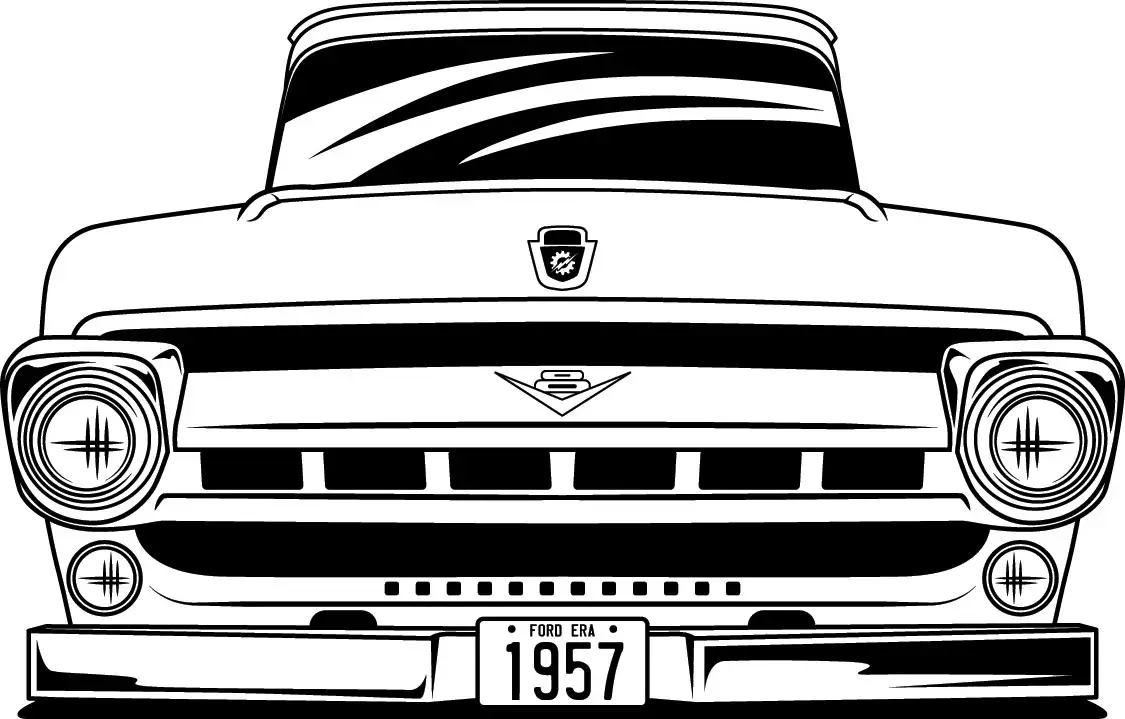
Ford stated that the ’57 was ahead of the competition in a variety of categories, including styling, comfort, safety, load capacity and power. Compared to the ’56 F-100, The ’57 was a completely redesigned truck, whose styling eventually changed the entire pickup truck industry. The rounded, big fendered look of the ’50s made way for a square, wide, and forward leaning truck that appeared modern and rugged. But this design wasn’t just created for appearance purposes only. It allowed for more room under the hood, in the cab and, most importantly, in the bed.

Although there was still much excitement over the major change in bed styling, the 1958 F-100 was in the midst of sluggish sales. Fortunately, the styleside models were less expensive for Ford to produce, and after its introduction in 1957 this body style continued to be popular among truck buyers.

So, Ford decided to keep things as they were and made only minor changes to the trucks’ appearance by adding quad headlights and an upgraded grille. The quad headlights distinguish the ’58 from the previous year trucks. The new grille emphasized the lights with a large crossbar that ran across the front and has an egg crate center section. This made the 1958 strikingly different without having to make a major makeover.
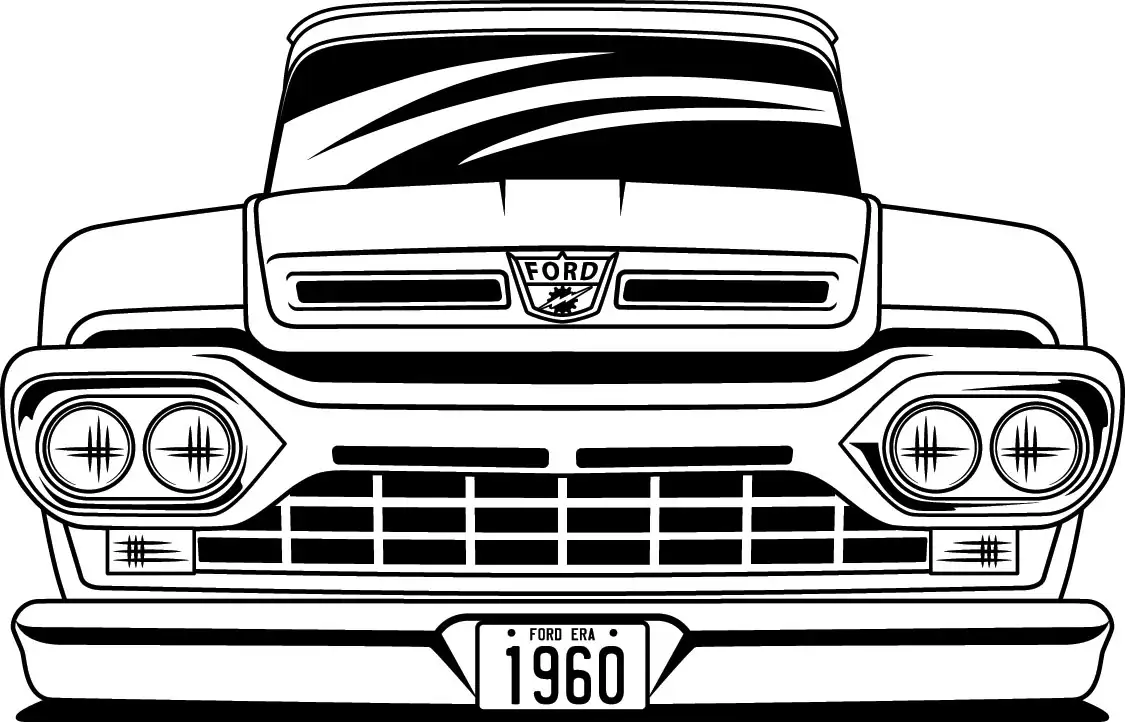
The 1959 visually did not appear much different from the 1958, with the exception of a new grille. The wide center bar was progressively getting smaller from the time it appeared on the ’57 model year truck. The newer 1959 grille had four center bars around a slightly thicker one at the top. The grille still wrapped around the four headlights, however, it had rectangular parking lights that were still positioned below the headlights. A larger intake in the front of the hood featured a mesh grille with the Ford lettering across the front of it. The rest of the body remained the same as in 1958.
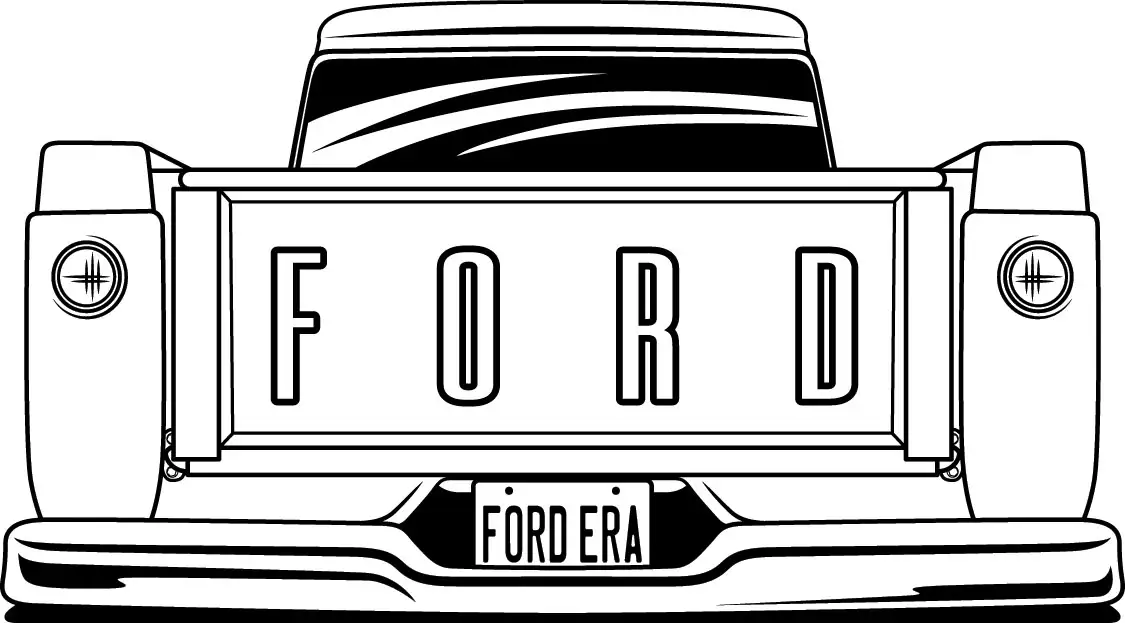
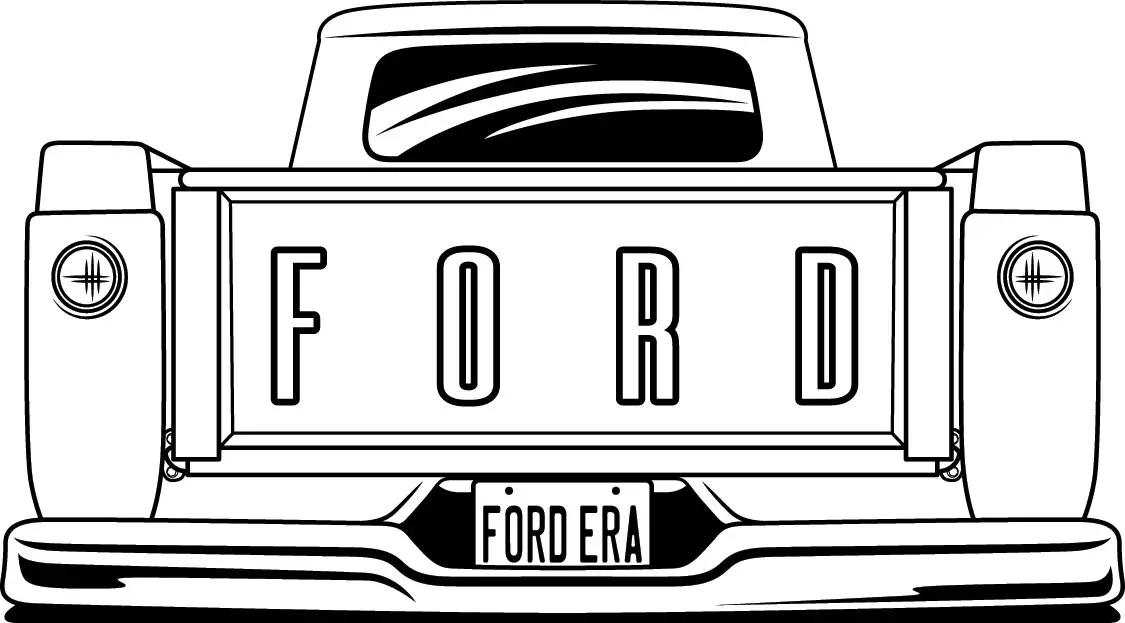
Ford kept on playing around with the front grille, and in 1960 changed it so that the top crossbar was larger than the inset bars below it. The grille still wrapped around the quad headlights, but now the parking lights were inserted into the grille. The air intake on the front of the hood was also changed. Instead of the mesh grille, Ford added two separate intake openings, and added a new gear and lightning Ford crest. The side hood emblems also changed and featured a rocket with the Ford emblem. The rest of the trucks’ exterior remained pretty much the same as it did in ’59, but many small refinements were made.
The Ford designers were quite good at pushing the envelope of design on their F-Series trucks and continued to lead the pack in truck design and function. This new generation released the very controversial unibody design, incorporating the styleside bed with the cab. Although short lived, it is one of the best looking F-100s ever made. Ford designers thought to integrate the bed and cab so there was no separation between the two, allowing the truck to have a continuous piece of sheet metal from the cab to the back of the bed.
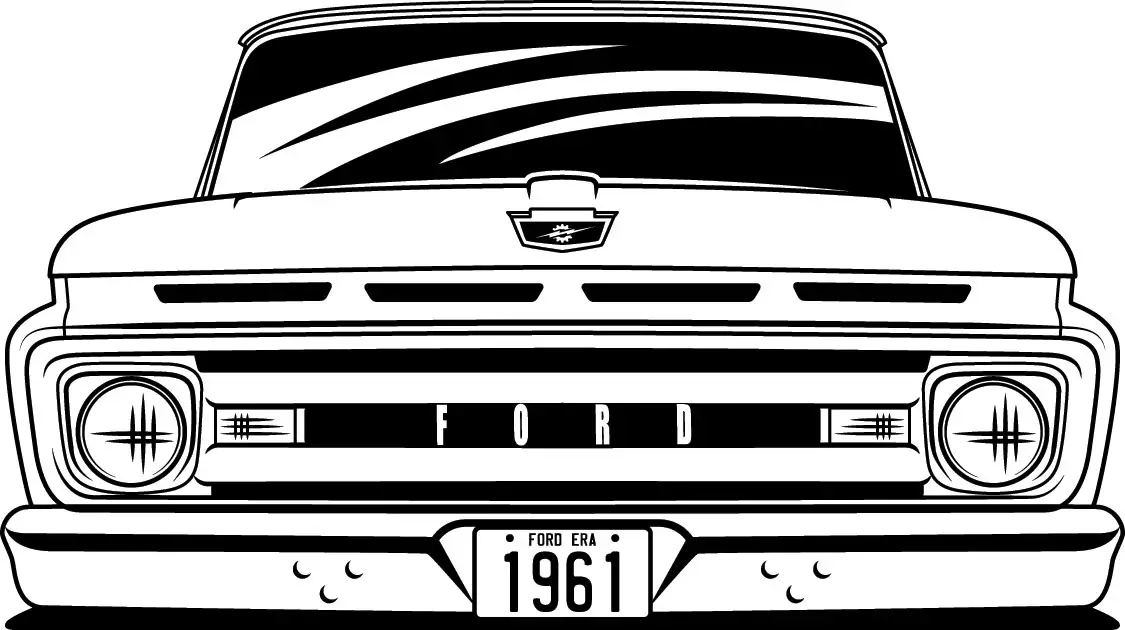
Although it appeared as a design characteristic that would majorly enhance the appearance of the truck, the concept actually made it less expensive to produce. Using fewer sheet metal stampings lowered the costs. In addition, the bed sides required fewer attachment points, as they were welded to the door sills and also created the back of the cab. While it is known as the “unibody” the chassis and body are not really united, as the body still sits on a full framed chassis.

Nevertheless, it made the truck look great and accentuated the appearance of the popular styleside pickup. In addition to all of this, Ford touted that there was more space in the bed. The new cargo area provided 9 cubic feet of additional space than previous models had, equaling 16 percent more load space.
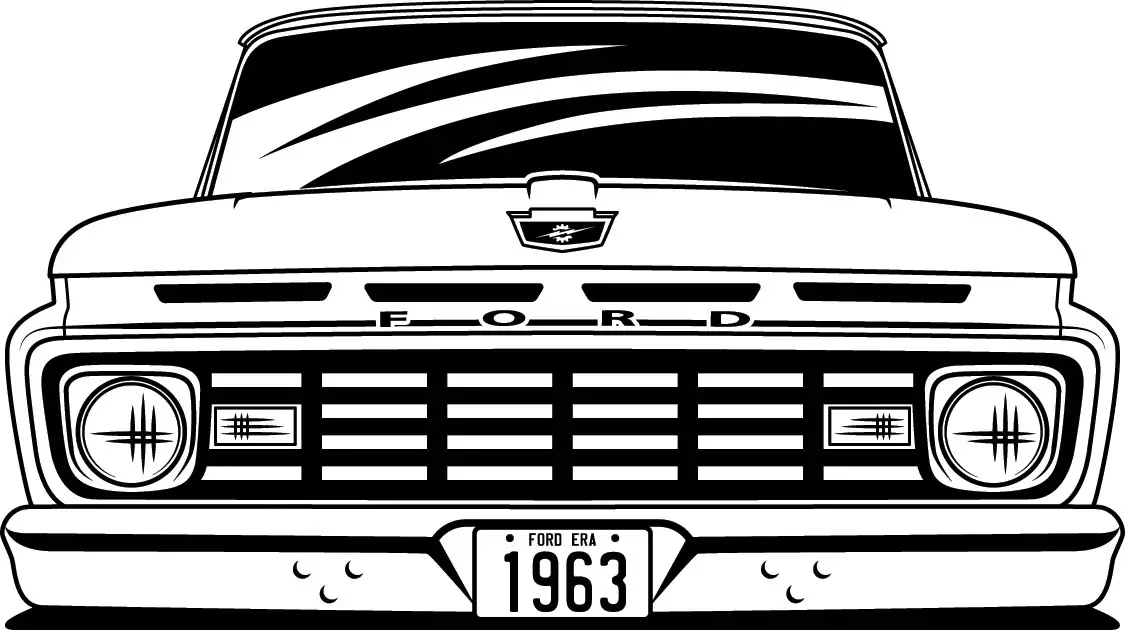
Changes to the grille were quite different from those on previous models. Ford went back to using two headlights instead of four, and the 1961 grille was now sleeker, slimmer and more modern. It had two horizontal bars with headlights at each end. The Ford letters were set into the center of the grille, which has a wide opening stretching across the front, and the entire grille was surrounded with a molding. The hood of the ’61 F-100 was still very square, but sleeker in appearance, with four vent openings underneath the pointed edge that ran along the entire front width of the hood. The Ford truck badge was centered on the front of the hood, and the sides used the rocket style Ford F-100 spear emblems.
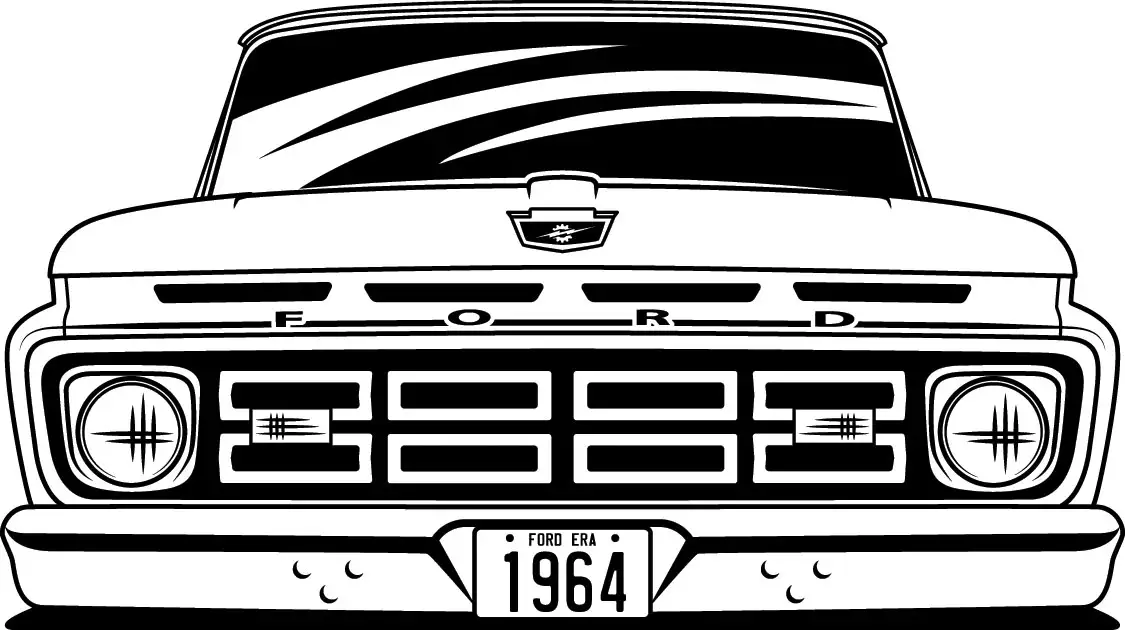
Not much changed on the 1962 model F-100 pickups, but the overall truck business was rapidly growing. Only slight changes were made to the 1962 F-100, which included a small grille change that incorporated a crosshair in the center. The Ford lettering was moved above the grille, just under the four hood vents. The rest of the trucks body remained the same including the front and side emblems.
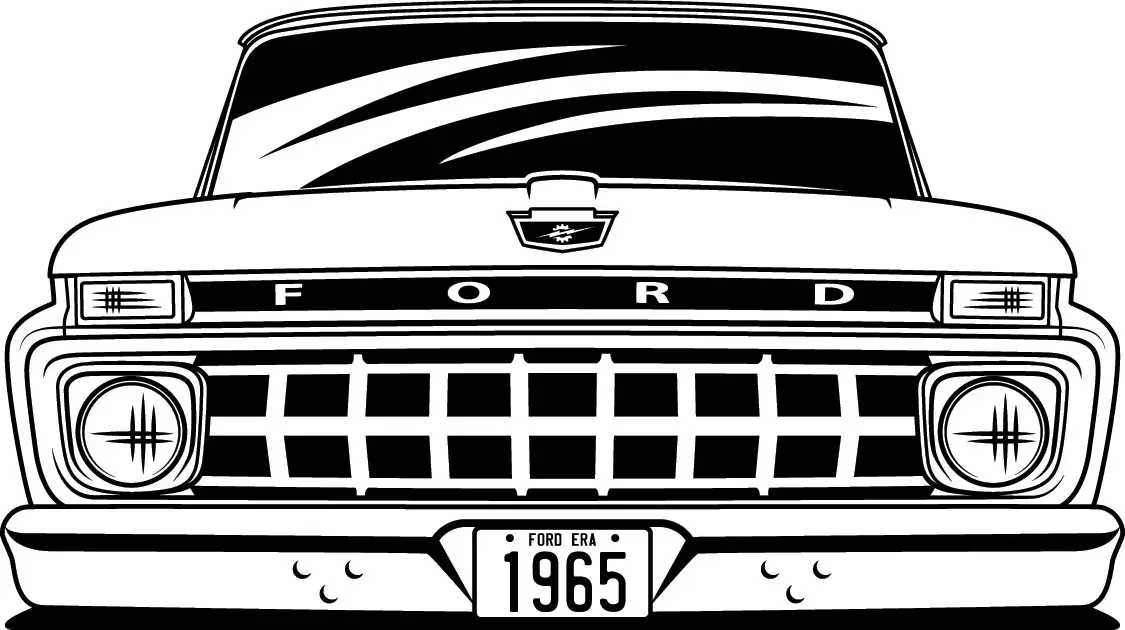
The 1963 model year was a transitional year for the F-100. The unibody design, while in thought and appearance seemed great, still had its drawbacks. It would flex a lot with heavy loads causing the doors to either lock you in or keep you out, among other little issues. Ford recognized the issues and in 1963 they knew it would be the end of the line for the unibody styleside pickup, and started to promote the regular styleside truck.
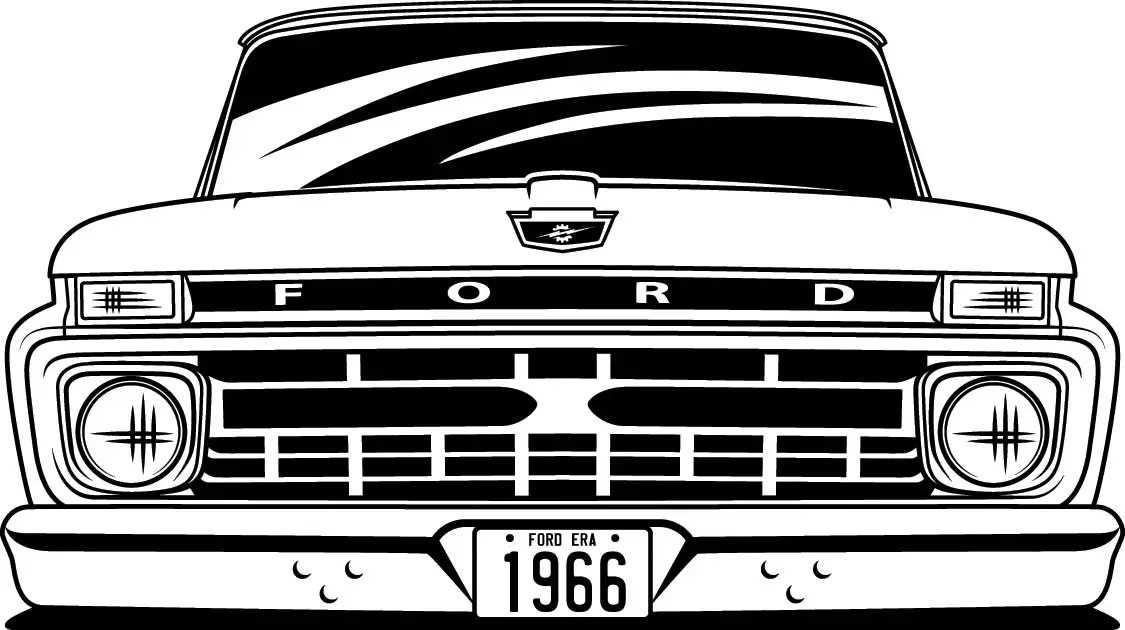
The truck got a few minor changes as in most years; a new grille gave the truck a more modern look and made it easily identifiable from the previous ’61 and ’62 models. It was now made up of aluminum with four horizontal bars that had six small vertical sections. They also revised the hood ornament for the V-8 model it has the V-8 crest and on the six-cylinder models it stayed with the sprocket on lightning bolt, the side emblems changed and a chrome side trim which extended from the front to the rear of the truck on the custom cab package.
…the company introduced the new Twin I-Beam independent front suspension that had coil springs…
In 1964 the unibody was completely phased out of production and the F-Series received some changes. One of the most notable changes was that the roof was 1 inch higher, giving more headroom inside the cab. The only real appearance change was the new grille; it was a little similar the ’63 grille, but now consisted of eight open squares across the front, divided into four vertical rows. The headlights still had the chrome surround. The Ford letters above the grille were now more spaced apart. Another notable part on the ’64 was the all new bed. The non-unibody ’63s were called “wrong beds” since the body lines from the cab and bed didn’t match. In ’64 Ford created a bed that gave the truck one solid body line and it looked very fitting to the truck.
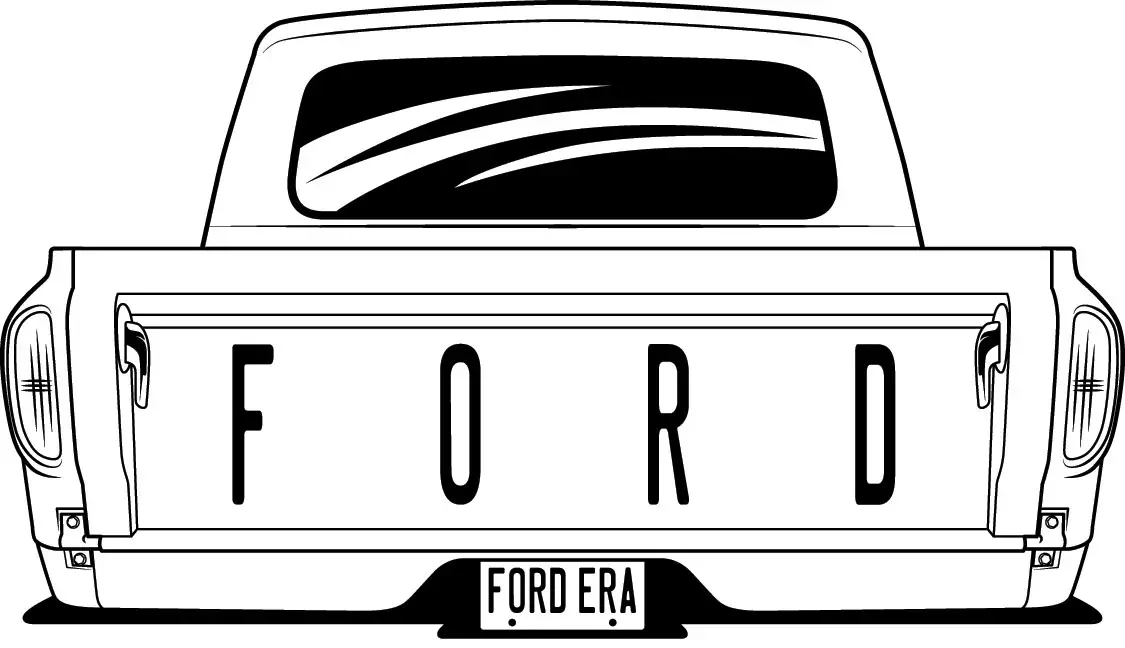
Ford Motor Company sales were up 22 percent in 1965. A big change came to the F-Series trucks. It was not an aesthetic change but a suspension change. In the past, Ford utilized an I-beam solid front axle. For 1965, the company introduced the new Twin I-Beam independent front suspension that had coil springs instead of leaf springs, and had larger shock absorbers mounted outside of the coil springs. The result was a much smoother ride and more axle control for better traction and handling.
Changes for the ’65’s appearance included a new grille that featured a set of rectangle openings set across two horizontal rows and placed in between the two headlights bezels. The turn signals lights got moved up above the grille surround, with the Ford lettering stretched out between the lights. A different style of side trim now extended from the front of the door to the rear of the truck.
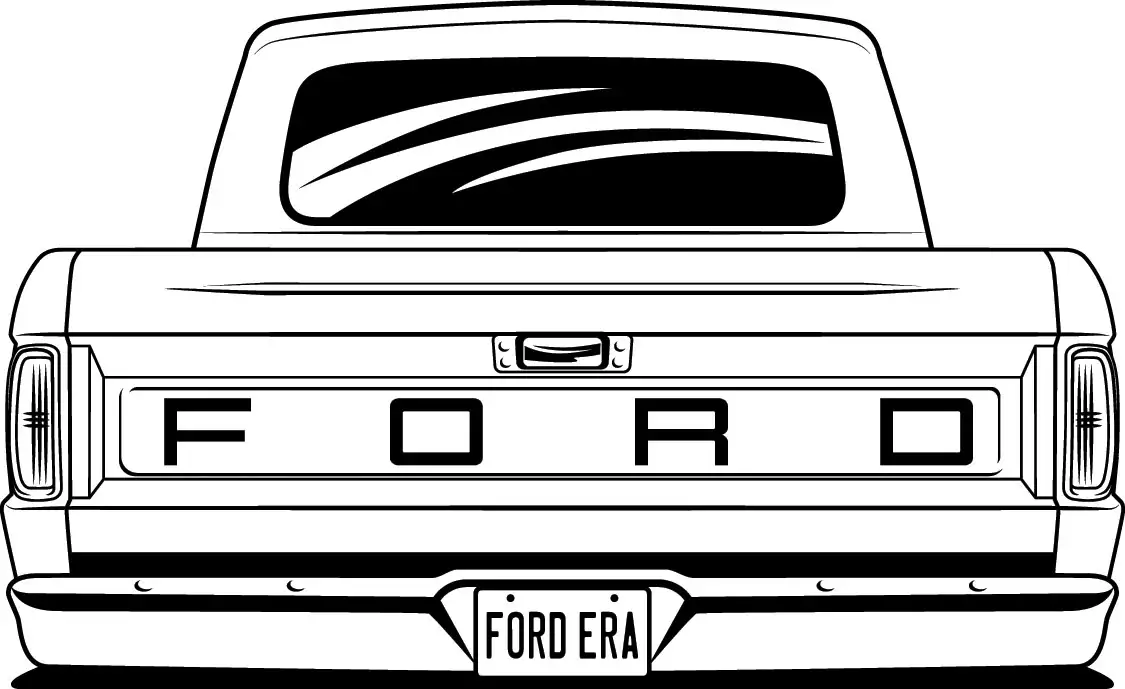
Not much had changed on the 1966 model F-100s this year, but company had become the No. 2 truck manufacturer; GM was No. 1 at the time. The F-100 received a new grille that featured two larger openings above a series of stamped rectangular openings. The rest of the truck’s body and styling was carried over from the previous year.
The F-100 of the late 1960s and early 1970s saw some of the most significant changes that would take the idea of the pickup truck into new directions. The truck changed body and chassis styles in 1967, which was so successful that only minor grille and trim upgrades were made to keep the truck fresh up until 1972.
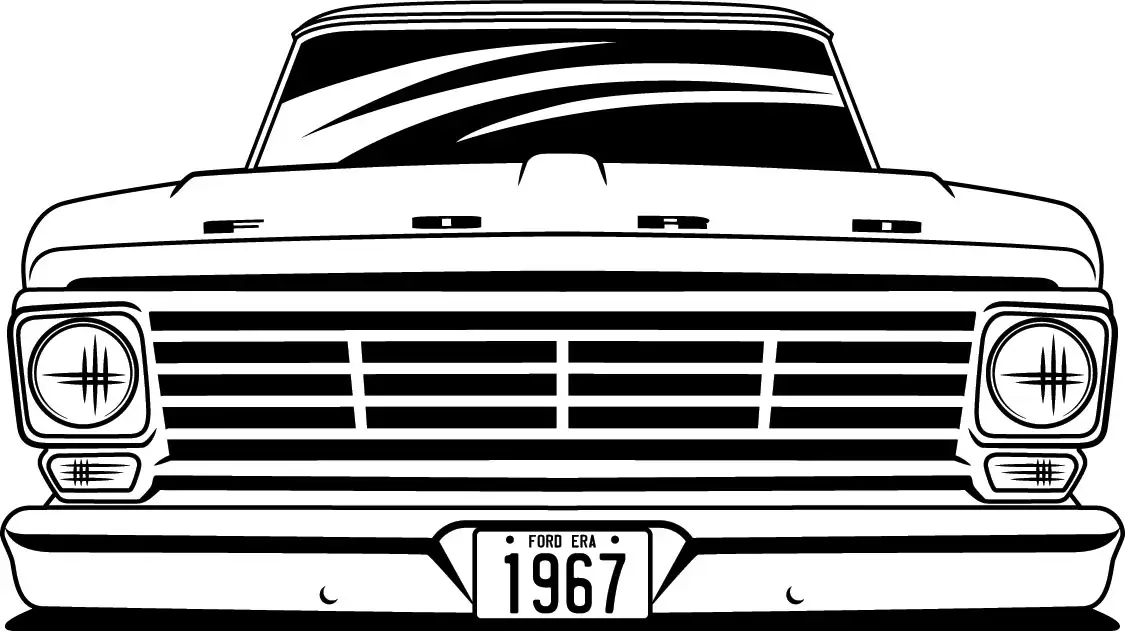
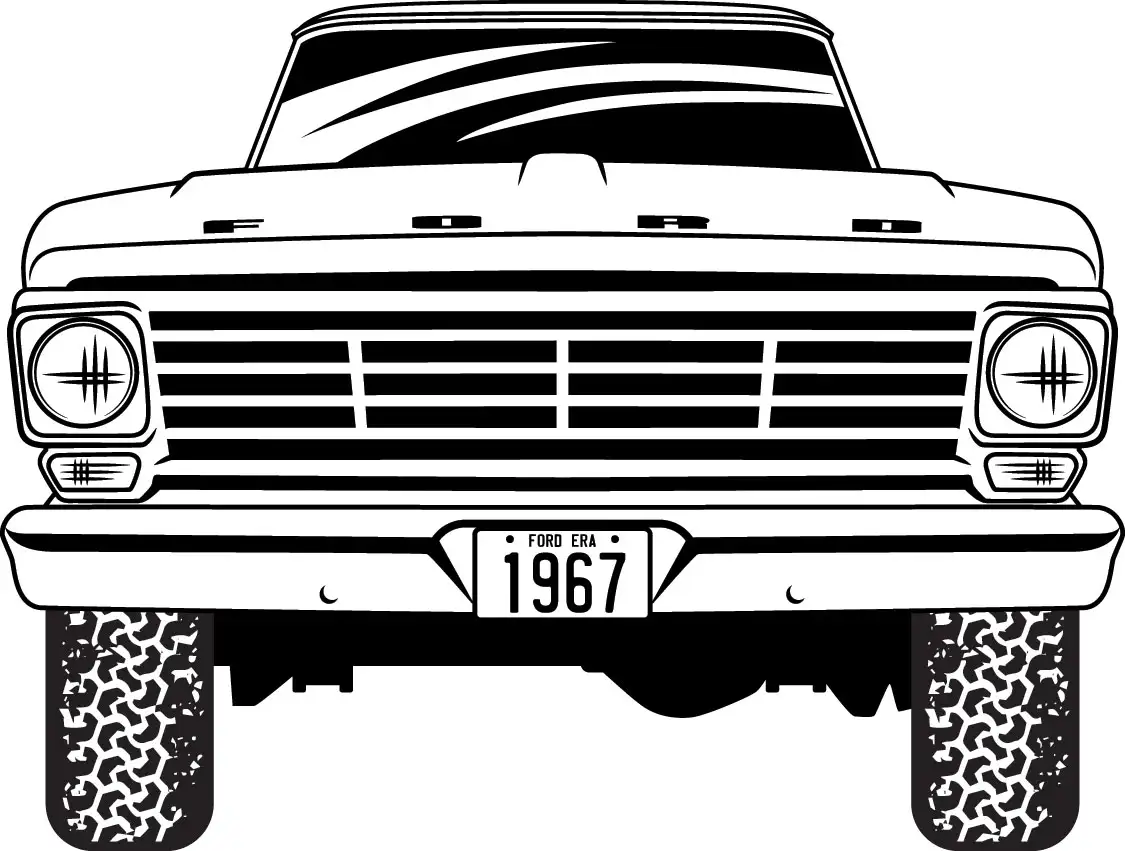
The 1967 Model was a big change from the previous models, initiating a new generation of truck that are still vastly popular for collectors and enthusiasts. Ford engineers completely restyled the new F-100 from the ground up. They made the cab wider, providing an additional 4 inches of in cab room. All new wider hood with a forward slant to it, with the Ford lettering stretched out across it. Side emblems were moved up closed to the front of the hood and were much smaller than in previous years.
The grille was wide, flat and had four rows of stamped slots with the headlights at each end. Turn signals lights were moved back down under the headlights and a wide front bumper followed the lines and wrapped in to blend with the fenders. It was and is definitely a great looking truck. Most people refer to this generation of trucks as the “Bumpside” due to the large bodyline sort of spear shaped, which is in a way a bump from the top to the bottom of the truck sides.
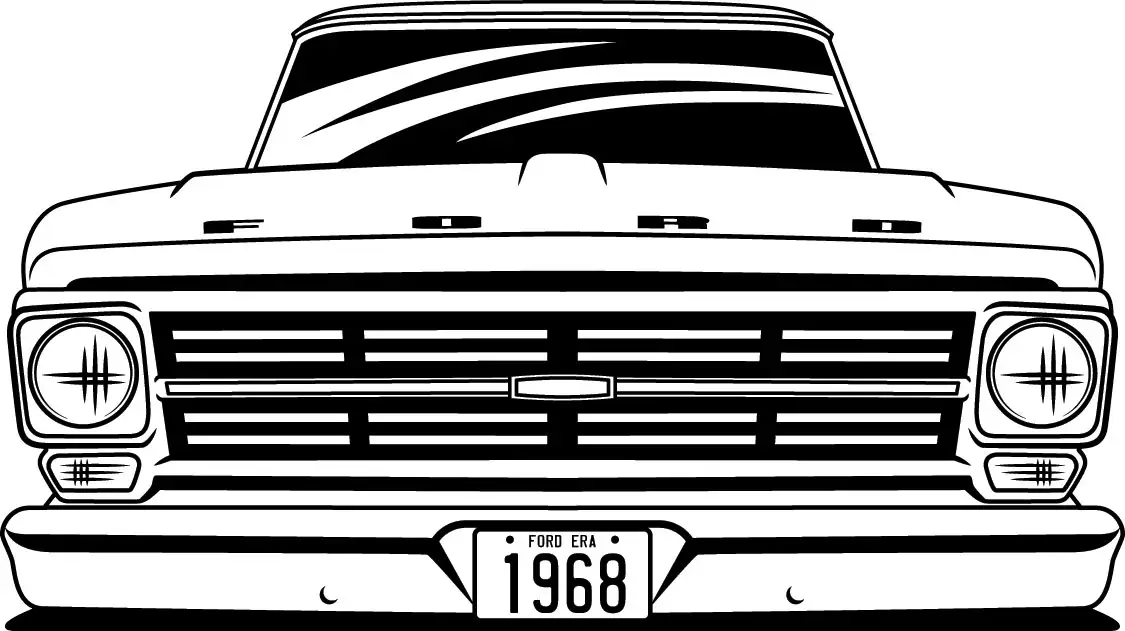

In 1968 Ford continued to refine its redesigned truck with a new grille that featured thicker upper and lower bars with a center crossbar that went across the full width. The F-100 series emblems remained in the same spot of the sides of the hood, but not incorporated the marker lights, which were part of a new federal safety mandate. Everything else on the truck remained unchanged.
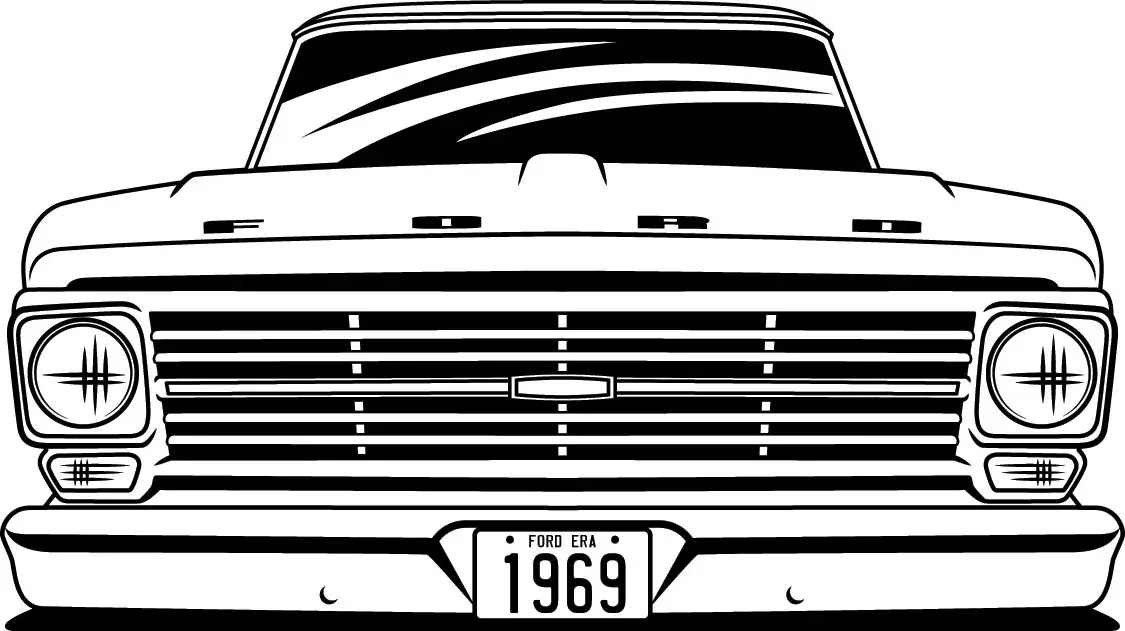
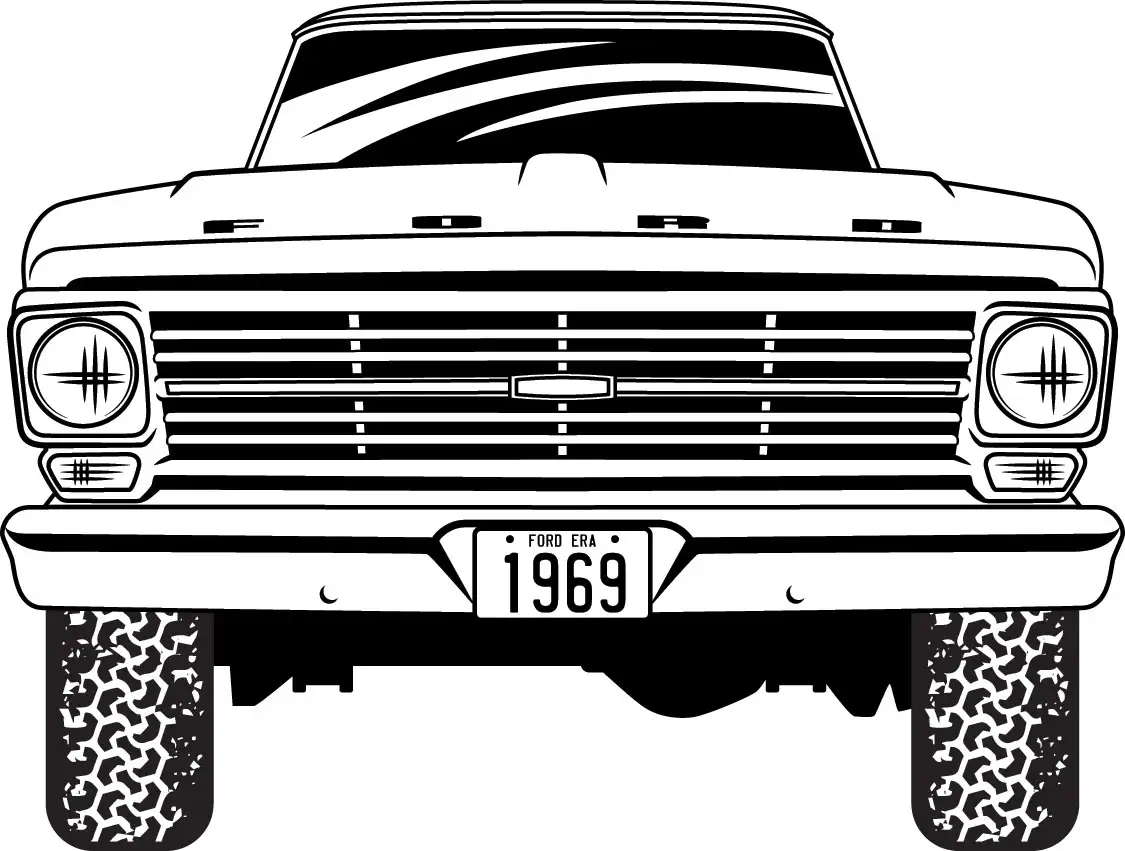
Although there were minimal changes to the 1969 F-100 as far as styling and interior design, the big news for this model year was the addition of the new 390 cubic inch V-8 that replaced the 352 engine. Only the front grille on the ’69 F-100 separates it from the ’68 model. It now had thinner openings and thinner horizontal cross bars, certain models also had a grille ornament in the center of the grille.
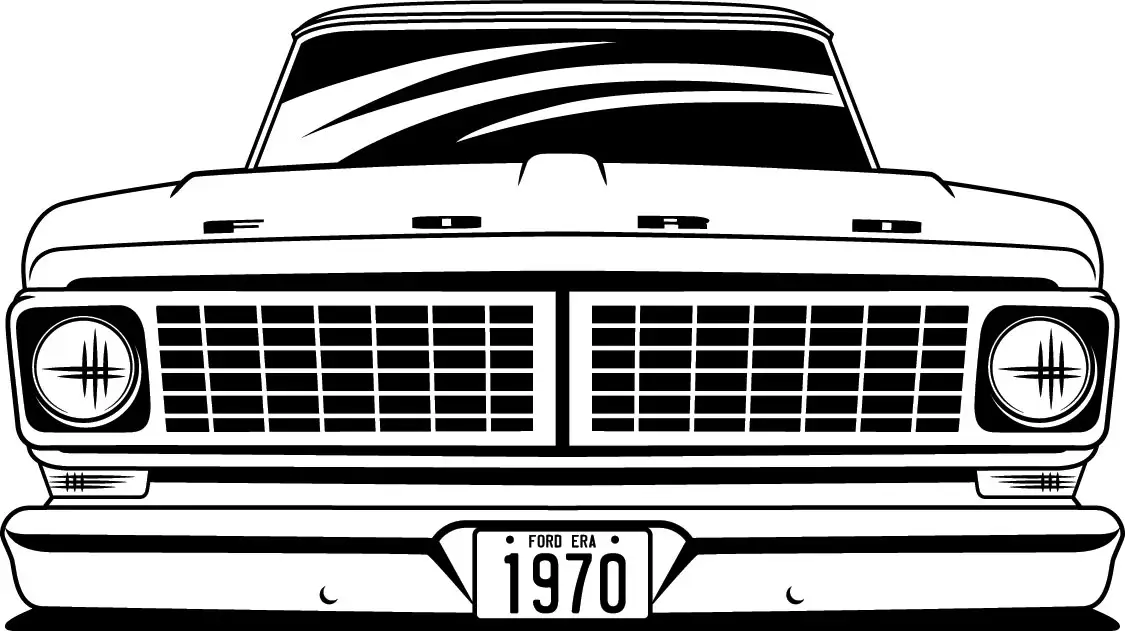
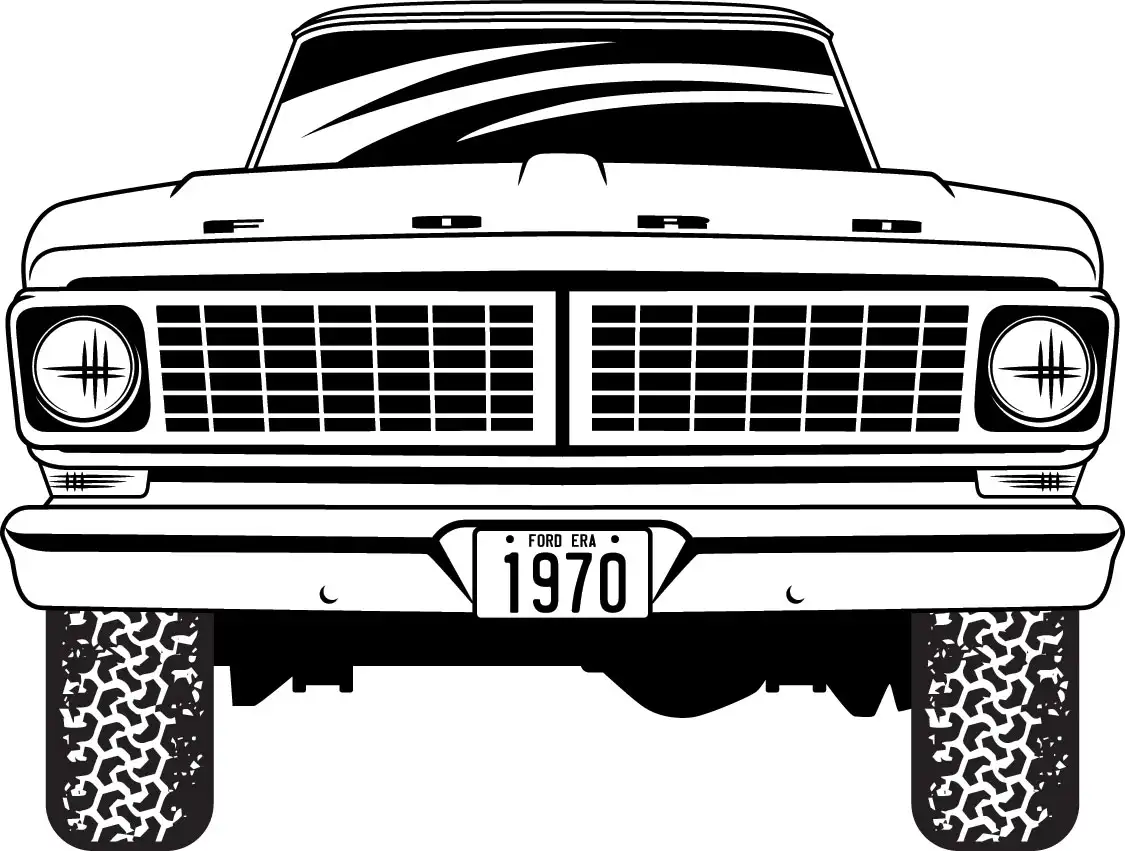
By 1970, Ford’s truck production was 36.5 percent of the entire truck market, according to Ford’s then-vice president, and it was the second-best sales season in Ford’s truck history at the time. However, the rest of Ford’s vehicle lineup didn’t fare all that well. With many emissions and government mandates placed on cars this year, Ford focused more on its truck lineup because the new restrictions did not apply there. Ford only updated the 1970 F-100 with a new grille and more engine and interior options.
The new grille featured a vertical bar in the middle that divided the small horizontal grids into two sections. The turn signals were previously located under the headlight bezels were moved lower below the grille trim, just above the front bumper. The side marker lights on the trucks body were now incorporated into the body side molding, which was a long spear that stretched across the entire length of the vehicle.
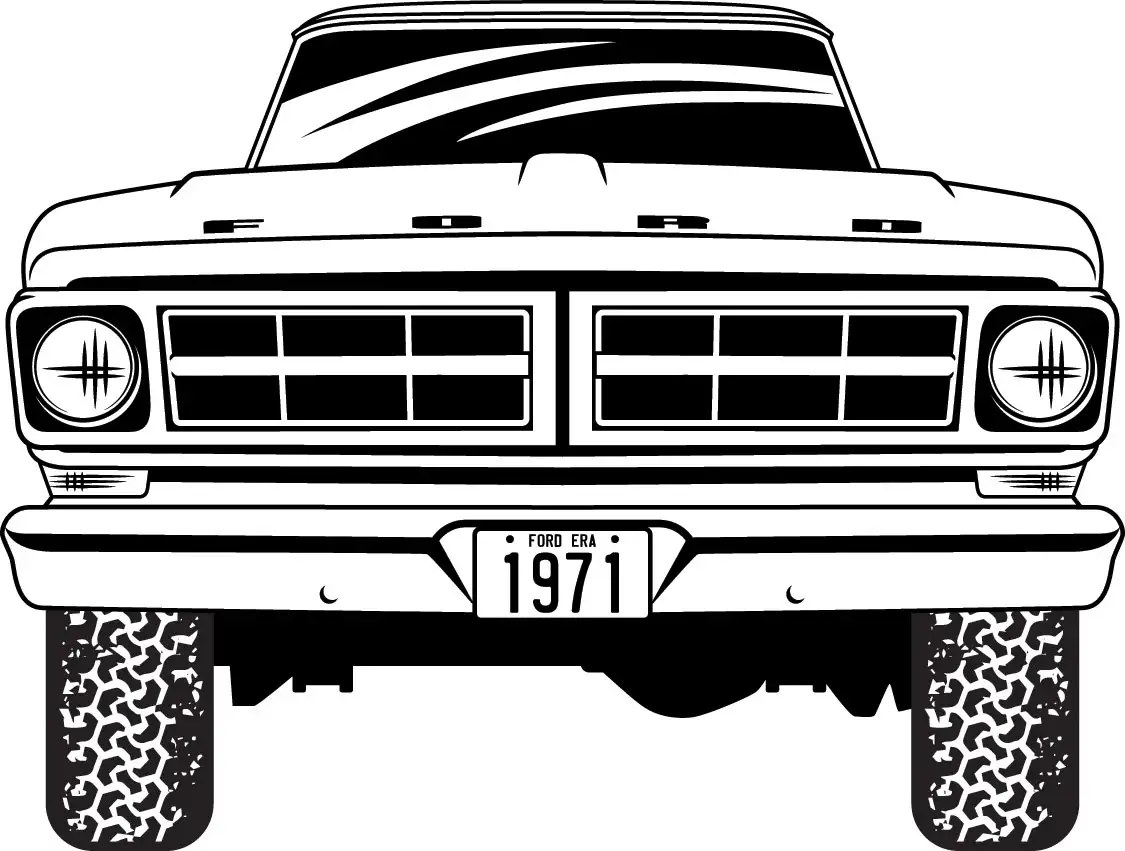
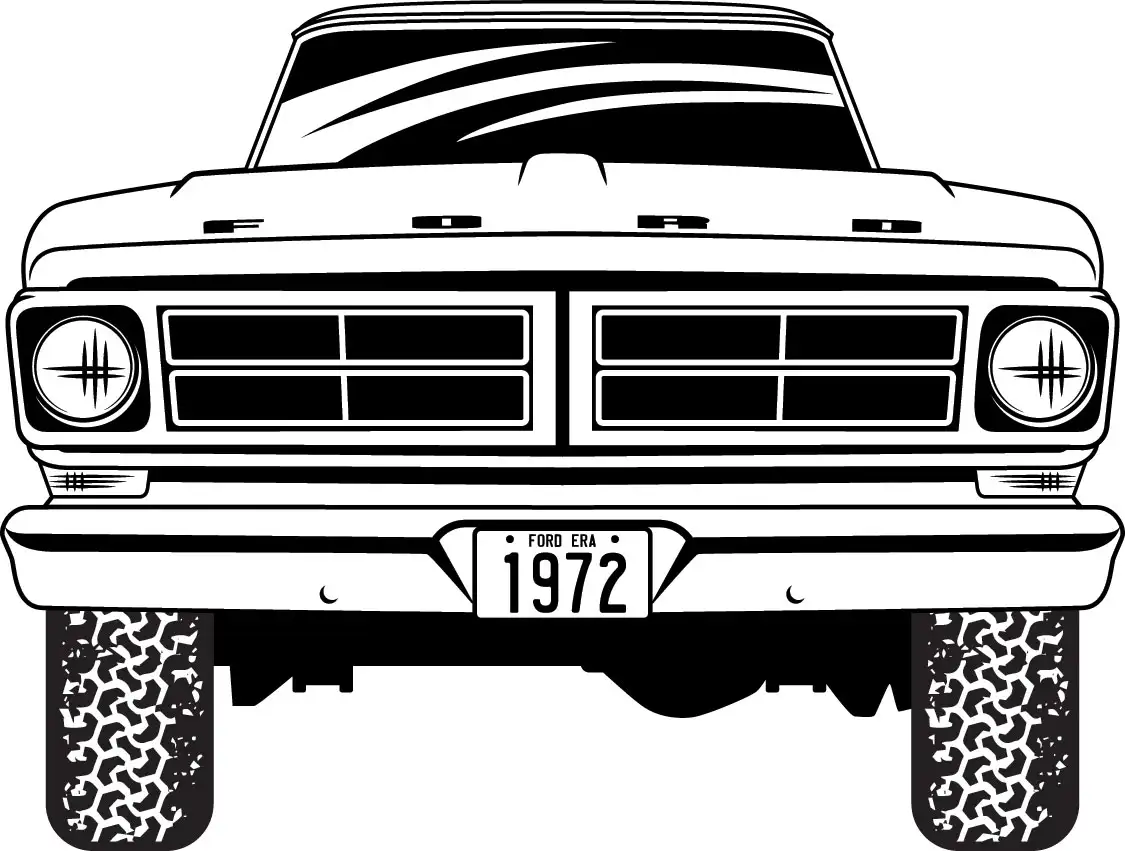
For the first time, Ford surpassed Chevrolet as being No. 1 in truck sales. In 1971, the company sold 515,443 light duty pickups in the United States alone, beating Chevrolet’s sales by more than 20,000 units. Leaving well enough alone, Ford left the F-100 unchanged for this year, updating only the grille. It was similar to the previous model, but the inserts (slots in the grille) were much larger and more pronounced. Leaving with the success of the last two years, the 1972 model once again was left unchanged with only a grille change, this time the inserts had four sections instead of six like in 1971.
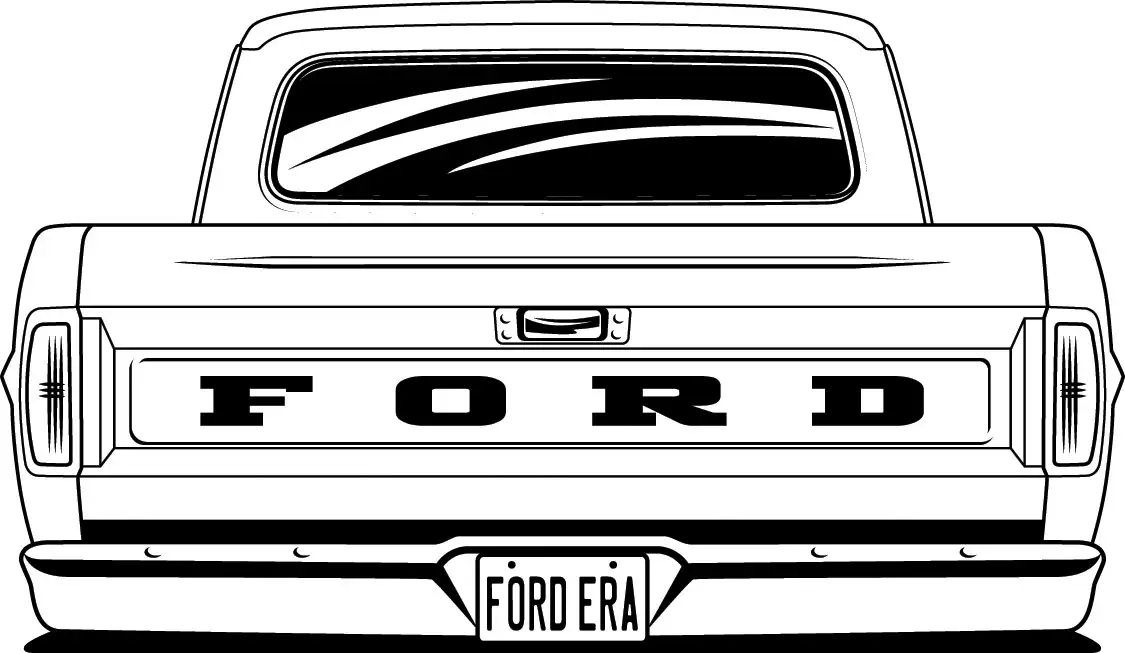

“If it ain’t broke don’t fix it.” The truck boom of the early 1970s was a turning point for Ford’s F-Series pickups. More people turned to buying trucks to have a vehicle with more capabilities and power. But trucks also proved to be easy and comfortable to drive every day.
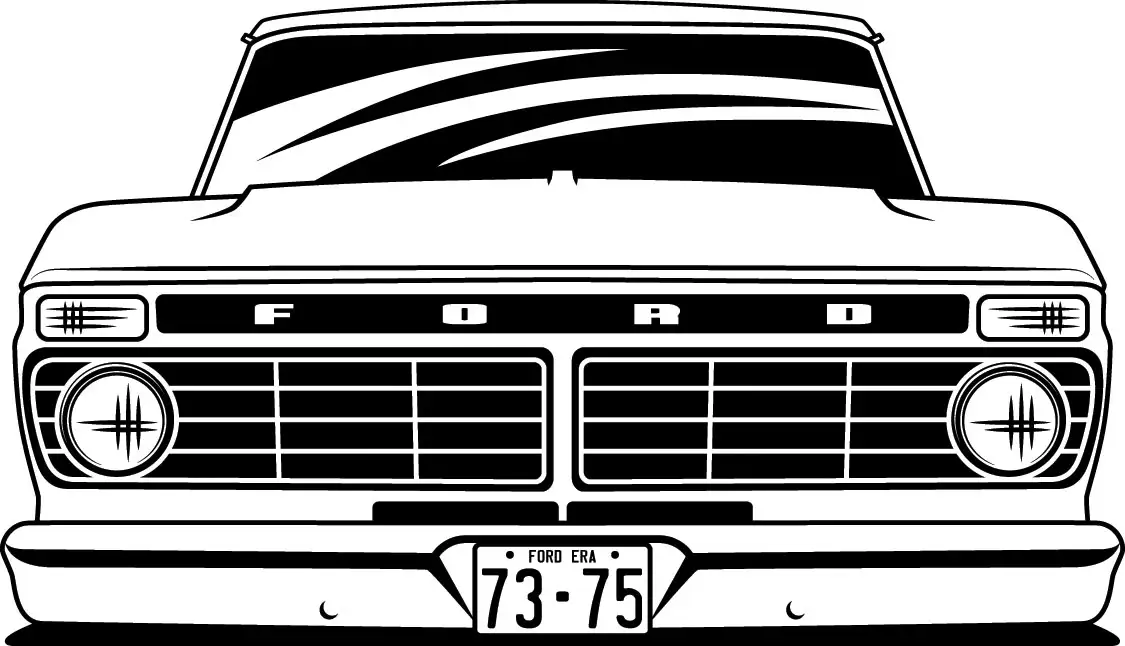
With Ford’s production setting record highs, the 1973 model year allowed Ford to try some significant changes to the F-100 that were disguised under a similar body style. Ford changed the outward appearance of the ’73 by inverting the so-called “Bump” into a “Dent”, henceforth this generation is known as the “Dentside.” They also added a new grille that featured thin inner squares with the headlight bezels completely removed. The two headlights floated inside the grille and seemed to be moved in slightly closer to the center.
Unlike ’71 and ’72 grilles that had the turn signals below the grille and just above the bumper, the signals lights were moved on top of the headlights, with an opening in between them that had the Ford lettering stretched across it. It also boasted a new hood, which was a little taller and more pronounced. One of the main things Ford found to enhance the trucks appearance was body side moldings. The truck now had the new inset dent which had the marker lights inside at each end and the option to have a chrome side trim there as well as on the bottoms of the truck.
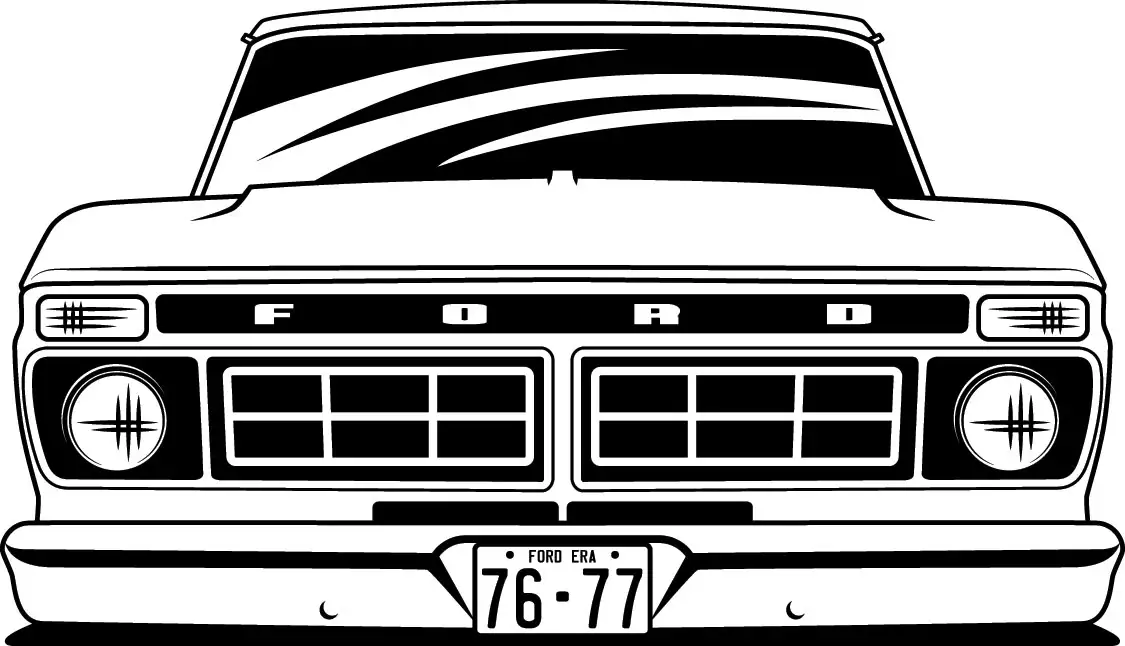
Ford produced over 1,000,000 trucks in 1974, taking ownership of 36.10 percent of the truck market. This was the third best sales year in Ford truck company history, allowing it to retain the No. 1 position over Chevrolet. In June of 1974, the company released a new model known as the Supercab. It was built on a longer chassis and provided an extra 44 cubic feet of space in the cab. It could be ordered with either rear full width bench seat or two facing jumper seats that could be folded out of the way. The aesthetics of the truck remained exactly the same for 1973, 1974 & 1975 model years. They didn’t even have a grille change (which was quite strange since they changed the grille constantly for so many years).
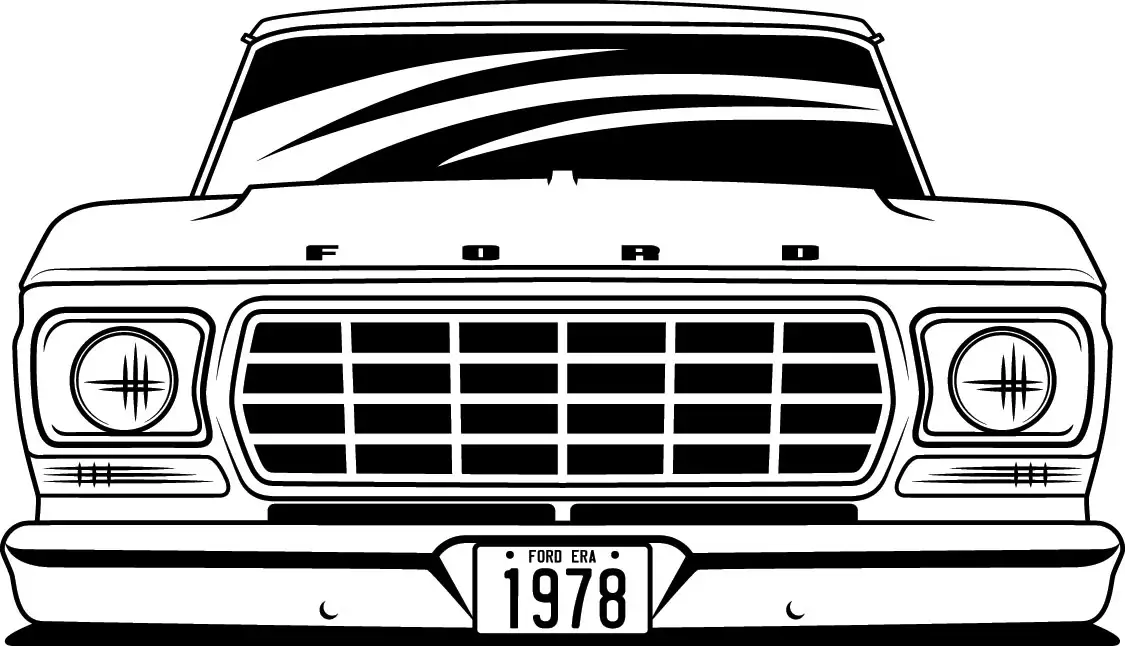
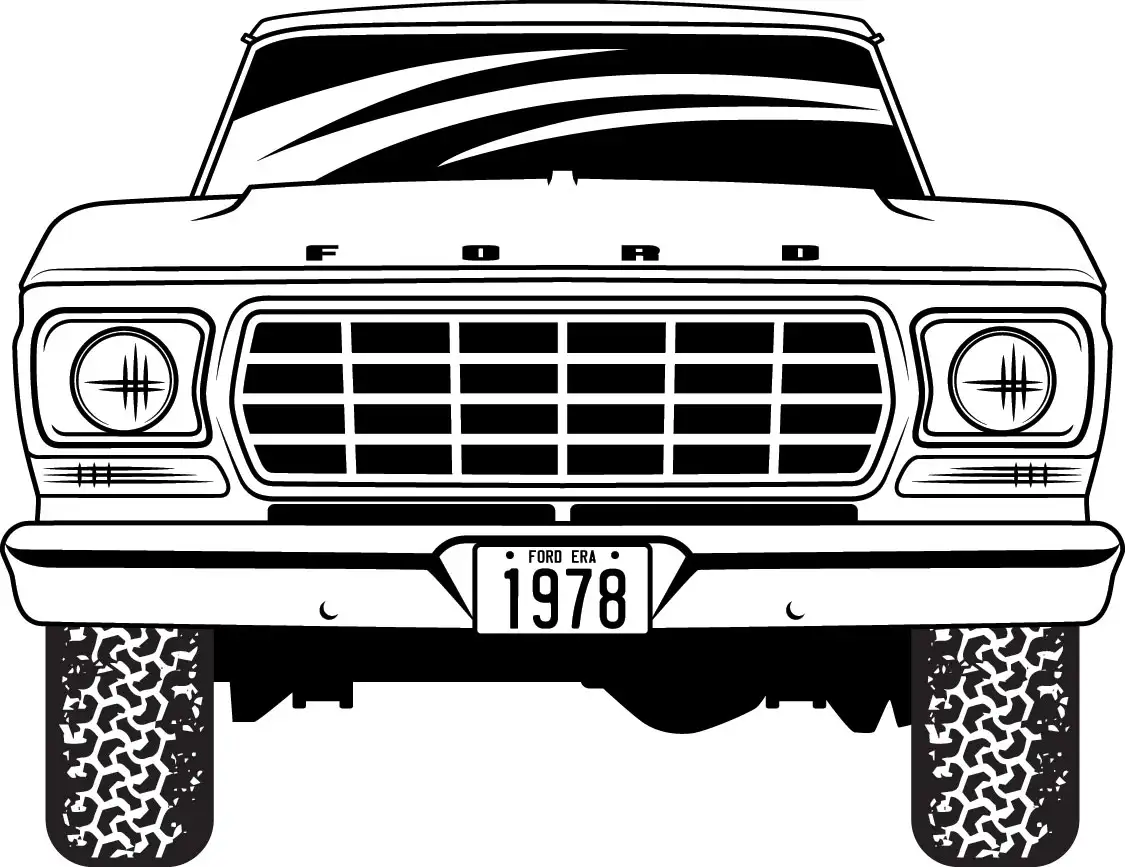
The bicentennial year for the United States was a time for celebration, but Ford had another reason to celebrate. While sales were down in 1975, Ford’s truck sales made a strong comeback in 1976. Ford updated the 1976 F-100 with a new grille that resembled the 1972 grille but had the headlights more recessed with thicker crossbars. The turn signals were still above the grille and the bottom of the hood. Aside from the new grille, The F-100 remained the same for the next model year of 1977.
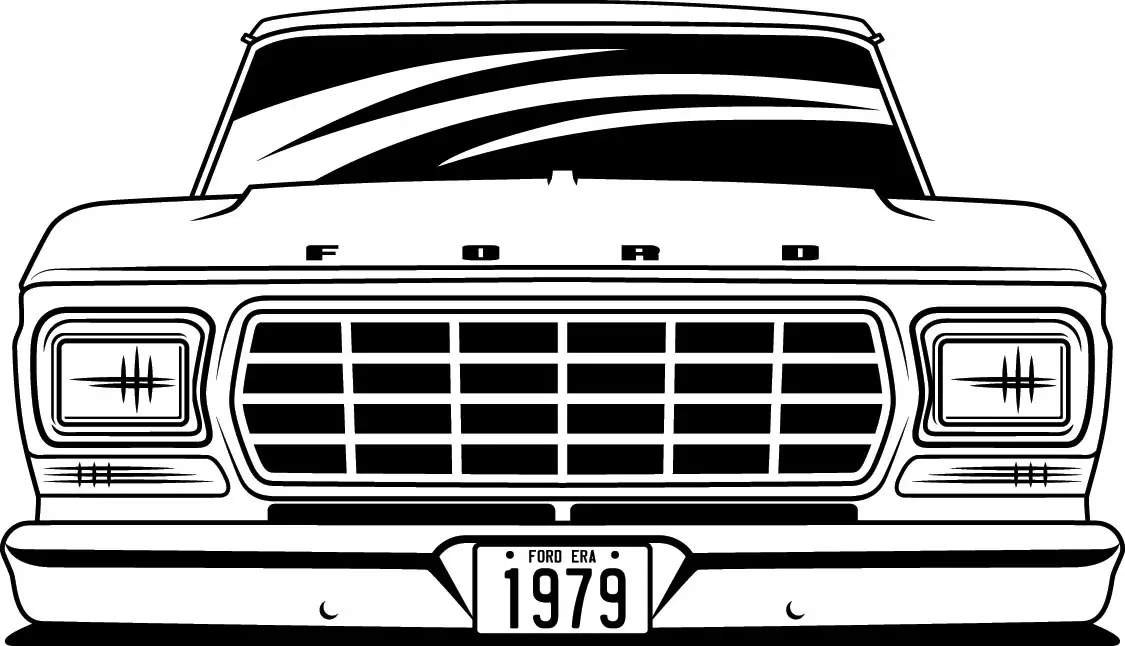
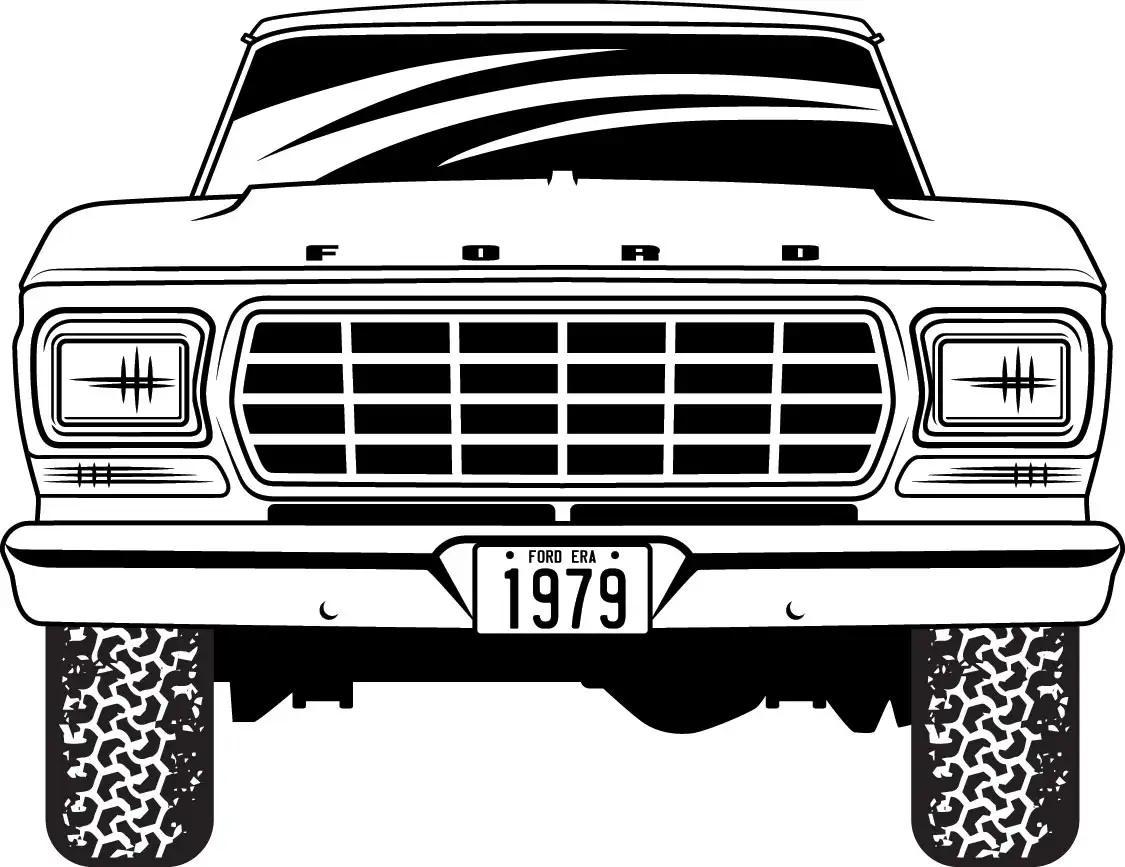
In 1978, Ford sold more than 1.3 million F-Series trucks, which was 60 percent of the entire truck market, making them No. 1 yet again. It seemed like Ford knew they had a good thing and mostly left the truck alone aesthetically. It did receive a new grille, which was now in the center of the new front trim. The headlights got a headlight bezel again, the turn signals were brought down underneath the headlights, and the Ford lettering made its way onto the hood.
No matter what generation you prefer, one thing is undeniable: These trucks are not going anywhere, and of course we’ll continue to celebrate them in all shapes and custom sizes right here!
Fords 1979 model year brought a new promotional campaign for trucks; the famous “Built Ford Tough” slogan made its debut. The round headlights were replaced by rectangular headlamps across all the trim levels. The truck, besides for the headlight shape remained the exact same as the ’78 model.
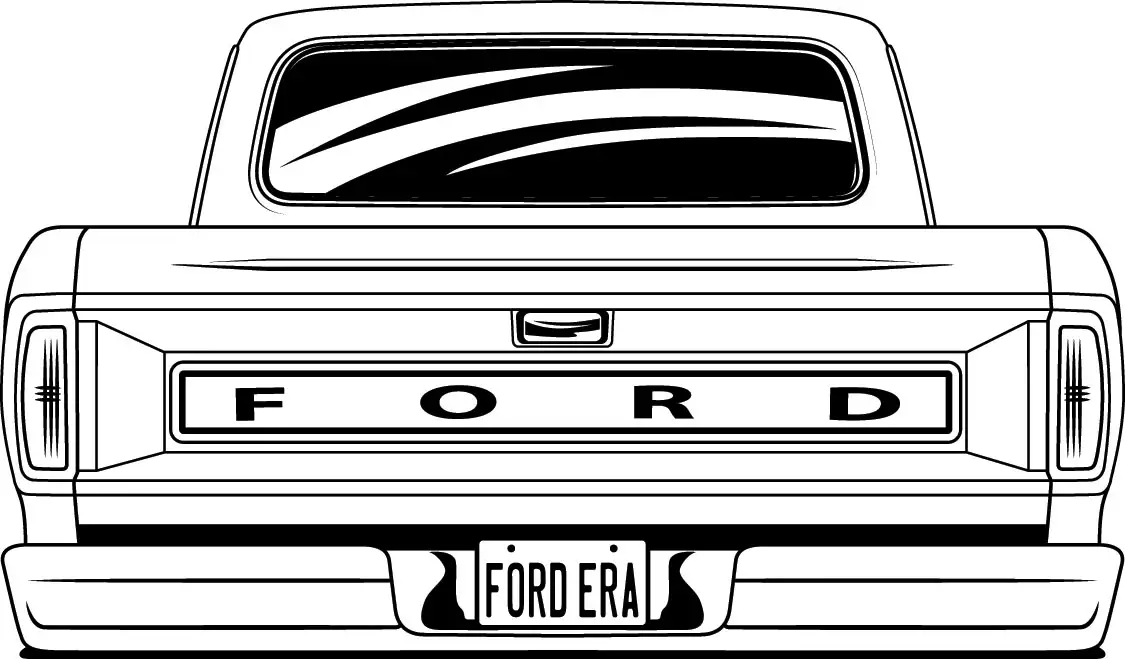
Ford Motor Company has now been producing the Ford F-Series since 1948, 70 years! So, we figured a 70th anniversary celebration was in order. They are the longest lasting trucks on the road and have sold more than 100 million trucks in that time. They have been America’s best-selling truck for the last 40 consecutive years. No matter what generation you prefer, one thing is undeniable: These trucks are not going anywhere, and of course we’ll continue to celebrate them in all shapes and custom sizes right here!
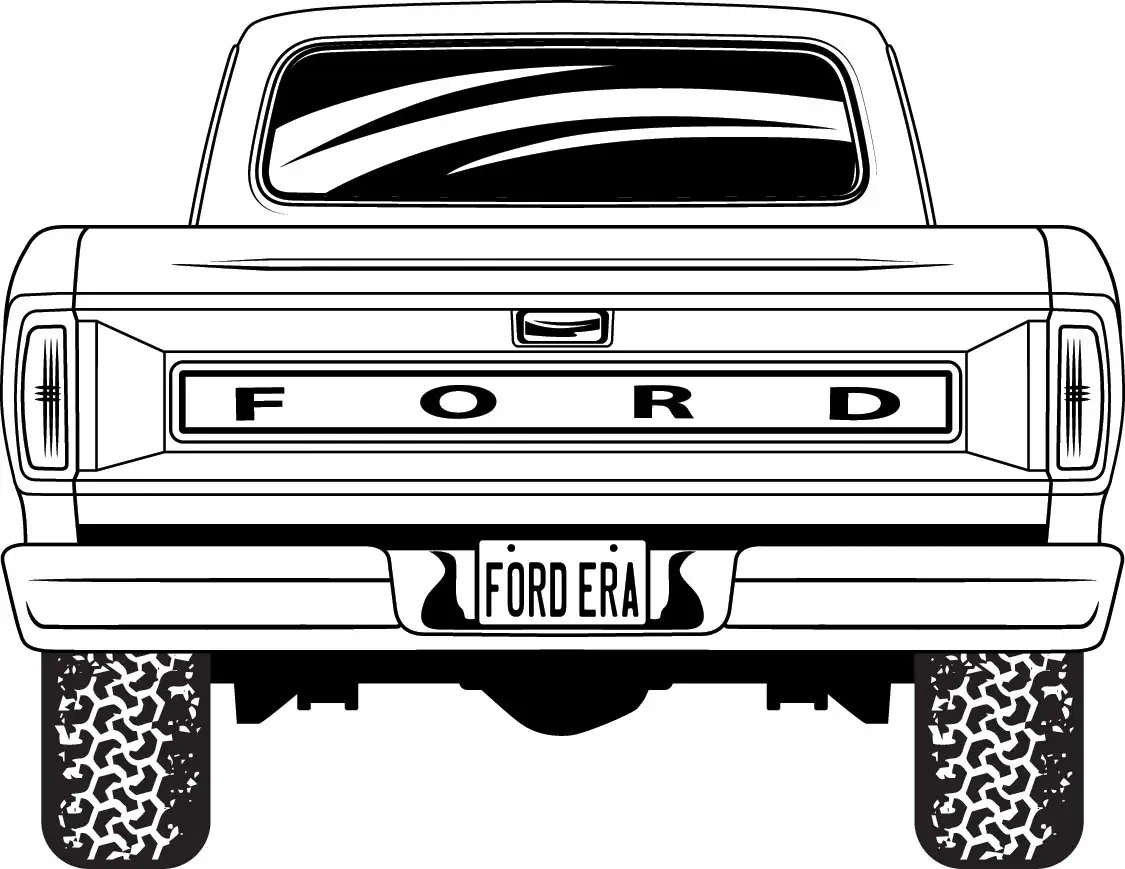
You can find all of these illustrations offered as stickers on Ford Era’s website www.FORDERA.com they have every year from 1948 up to 1997. Go give them a look as they even provided all of our readers with a special 15 percent off coupon code “F-100BG.” Just enter it at checkout.
2009 Model Year Enhancements:
2011 Model Revamp:
Transmission and Steering Upgrades:
These updates from 2009 to 2014 made the Ford F-150 more competitive in the market, appealing to a broader range of consumers by enhancing performance, efficiency, and driving experience.
Ford’s historical portfolio of trucks is a testament to its dedication to innovation and reliability. The journey began with basic, functional vehicles that evolved into today’s sophisticated machines, each playing a crucial role in automotive history.
Early Iconics
Technological Milestones
Recent Game-Changers
Technological Advancements
From the sturdy Model TT to the technologically advanced F-150 and Maverick, Ford’s trucks have continually evolved to meet changing demands. Their blend of innovation and reliability ensures they remain at the forefront of the automotive industry, blending tradition with modern needs seamlessly.
When the 2017 Ford F-Series Super Duty, also known as the Alumiduty, hit the market, it introduced several significant advancements:
Power and Performance Enhancements
The lineup saw the introduction of a robust 6.4-liter Power Stroke diesel engine, delivering 350 horsepower and an impressive 650 lb-ft of torque. This powerful engine was paired with either a six-speed manual transmission or a five-speed automatic, providing flexibility and control for different driving needs.
Innovative Features
New features included a tailgate step for easier access to the truck bed, making loading and unloading cargo more convenient. Additionally, standard equipment like an integrated trailer brake controller and comprehensive tow package were included, designed to enhance both safety and functionality.
Heavy-Duty Capabilities
One standout model, the F-450 Super Duty, came exclusively with the diesel option. It also featured heavy-duty specifications such as 4.30:1 or 4.88:1 gear ratios, which contribute to its exceptional towing and hauling capabilities.
Enhanced Towing and Payload
Equipped with 19.5-inch forged aluminum 10-bolt wheels, the Alumiduty was built to endure significant loads. It boasted a maximum tow rating of 24,500 pounds and a Gross Combined Weight Rating (GCWR) of 33,000 pounds, positioning it as a leader in its class for heavy-duty tasks.
Safety and Speed Regulations
Despite its immense power, the vehicle’s speed was electronically limited to 81 mph, ensuring that the heavy-duty truck maintained safe operating speeds under various conditions.
Overall, the 2017 Ford F-Series Super Duty offered a blend of power, innovation, and heavy-duty features that marked a significant advancement in its class.
The 1973 Ford F-Series brought an array of powerful engine choices to the table. This generation saw the inclusion of 302-, 360-, and 390-cubic-inch V-8 engines, enhancing both performance and versatility. Over its six-year production run, additional engine options like the 460 V-8 and the later introduced 351 and 400 engines further broadened the lineup.
Ford introduced several trim packages to cater to different customer needs. The Explorer trim package added a touch of style, while the contractor special offered practical features such as bedside boxes and a 110-volt generator under the hood. These additions made the truck highly functional for a variety of tasks.
Styling updates were a significant focus for the 1973 F-Series. Notable cosmetic improvements included a standard chrome front bumper, which added a touch of sophistication to the truck’s rugged look. The sixth generation also saw the debut of curved door glass, contributing to a more modern aesthetic.
A highlight of this era was the introduction of the SuperCab in 1974, inspired by the competition’s extended cab models. It featured a longer wheelbase, which provided additional space and moved the rear tires further aft, ideal for handling heavy campers.
Several technological upgrades were introduced during this generation. The F-Series featured front disc brakes for improved stopping power, intermittent wipers for convenience in various weather conditions, and tilt steering for enhanced driving comfort. Full-time options for 4×4 models also became available, offering better traction and control.
During this period, the Lariat nameplate made its first appearance, symbolizing a higher-end trim option focused on luxury. Additionally, the F-150 model was introduced, marking a significant expansion in the F-Series lineup. The F-450 model also emerged, catering to those needing greater towing and payload capacities.
In summary, the 1973 Ford F-Series marked a pivotal point in the history of Ford trucks, offering a blend of powerful engines, functional trim packages, modern styling, and innovative technological features. The introduction of the F-150 model added a new dimension to the brand’s already diverse lineup.
In 1997, the F-Series underwent significant changes, particularly between the half-ton and heavy-duty (HD) models. The half-ton F-150 debuted a new lineup of engines, featuring a 4.2-liter overhead valve (OHV) V-6, which was an upgraded version of the earlier 3.8-liter Essex engine. Additionally, it offered new single overhead cam (SOHC) V-8 options: a 4.6-liter producing 220 horsepower and a 5.4-liter generating 235 horsepower, both of which replaced the older small-block engines.
Transmission choices for the half-ton included a four-speed automatic and a five-speed manual sourced from Mazda. The SuperCab version adopted a rear passenger-side door similar to General Motors’ design, facilitating easier access to the back seats. By 2001, the lineup expanded with the introduction of the SuperCrew, a four-door variant that provided even more convenience and space for passengers.
In contrast, the heavy-duty models did not incorporate these engine updates or design changes, maintaining a distinct separation from the half-ton trucks.
The 1917 Ford Model TT was a pioneering heavy-duty vehicle, serving as an early example of a chassis cab design. Here are its key specifications:
These specifications made the 1917 Model TT a trailblazer in the realm of heavy-duty trucks, setting the stage for future advancements in the industry.
Between 1987 and 1991, the F-Series saw several notable changes. One of the first updates was the introduction of flush headlamps, which while cost-effective for bulb replacements, proved more costly if the lens broke. This period also marked the arrival of antilock rear brakes and port fuel injection.
Another significant change was the temporary removal of the Flareside model, which would not reappear until the redesign in 1992. During this time, automatic locking hubs were introduced, enhancing convenience for users. Additionally, the half-ton models were updated with pushbutton four-wheel drive, streamlining the transition between drive modes.
These enhancements reflected ongoing innovation and improvements aimed at enhancing performance and user experience.
The 1993 F-150 Lightning stood out for several reasons, starting with its distinctive cosmetic changes. It was the last model featuring classic vent windows and rain gutters, giving it a nostalgic touch.
Performance Enhancements:
Engine and Power:
Unique Design Elements:
In summary, the 1993 F-150 Lightning combined impressive performance, unique design features, and enhanced handling, making it a standout vehicle in its class.
In 1959, Ford made a significant leap in automotive innovation by introducing factory-installed four-wheel drive in its trucks. This marked the first time one of the major American automakers offered this feature directly from the production line, eliminating the need for third-party conversions typically handled by companies like Marmon and Napco.
New Ranger (2024):
The 2024 Ranger brings a fresh design and enhanced capabilities just two years into its existing lifecycle.
Ranger Raptor (2024):
The standout addition to the lineup is the Ranger Raptor, designed to deliver high performance both on and off-road.
These key features establish the 2024 Ranger and Ranger Raptor as impressive contenders in their category, boasting a combination of advanced technology, enhanced power, and rugged durability.
The second-generation F-150 Lightning, launched in 1999, introduced several enhancements and new features compared to its predecessor:
These features combined to make the second-generation F-150 Lightning a formidable performance truck with a blend of power, handling, and distinctive styling.
The 1935 Model 50 introduced several important advancements that redefined pickups of its era. One notable improvement was the introduction of evolutionary body design enhancements. The vehicle featured more streamlined bodywork, which not only improved aesthetics but also aerodynamics.
These advancements collectively made the 1935 Model 50 a significant contender in the pickup market, blending practicality with increased performance.
The third-generation Raptor, introduced in 2021, brought significant advancements to the table, enhancing its already legendary performance. Here’s a breakdown of the key improvements:
These enhancements collectively positioned the third-generation Raptor as a more robust and versatile off-road powerhouse, building significantly on the strong foundation of its predecessors.
The Ford Ranger first made its debut in 1983. From its introduction until 1997, the truck maintained relatively consistent features with minor changes in engine options and a sleeker body design over time.
Further improvements came in 2001, when the overhead-valve engine was replaced by an overhead-cam version of the 4.0-liter V-6, boosting power to 207 horsepower.
These updates not only modernized the vehicle but also improved its handling and performance, making it a more robust choice for truck enthusiasts.
The 2017 second-generation Raptor marked a significant leap forward from its predecessors, emerging after a two-year production hiatus. This model stepped up its game, bringing a slew of improvements that elevated its performance and appeal.
This combination of enhancements made the 2017 second-generation Raptor not just a successor, but a superior successor, turning it into a formidable force in the off-road vehicle market.
The 1991 Ford Explorer revolutionized the SUV landscape in several impactful ways. Initially designed to improve upon its predecessor, the Bronco II, the Explorer introduced features that catered specifically to families. Unlike the typical two-door design, it adopted the more practical four-door layout, similar to the Jeep Cherokee XJ.
The Ford Explorer’s debut marked the beginning of a new era for SUVs, setting a high standard for both performance and family-friendly features.
The 1975 Ford Econoline marked a pivotal moment in Ford’s truck history thanks to its innovative body-on-frame design. This engineering choice made the Econoline versatile, suitable for a variety of applications ranging from cargo hauling to passenger transport. Here’s why it stood out:
In essence, the 1975 Econoline’s introduction of the body-on-frame design set a new standard for versatility and durability in the automotive market, solidifying its place in history.
In November 1947, the first F-Series pickup rolled off the assembly line in Highland Park, Michigan. Then on Jan. 16, 1948, Ford announced its newly designed Ford F1 pickup truck. The new F1 was built on a 114-inch wheelbase. Compared to the previous model, the new F1’s cab was 7 inches wider and provided more headroom. The front fenders were also wider, taller, and designed to look like a single piece that wrapped around the front. The rear fenders were no longer teardrop-shaped. Instead, they were more rounded and continued the side body lines of the truck from the front all the way to the rear.
The first F-Series, known as the “Bonus Built” line, included models ranging from the half-ton F-1 to the 3-ton F-8. This line featured a distinctive five-bar grille, and the half-ton models came with engine options like a 226-cid 95-hp flathead-six or a slightly larger flathead V-8 with 100 hp. These engines were paired with either a three-speed or four-speed gearbox. New functionalities included a passenger-side wiper, taillight, and optional four-wheel drive provided by Marmon-Herrington.
Previous models had a vertical grille, but the new F1 was distinctly different with a wider five-bar horizontal grille, with the turn signals integrated into the top grille bar. The familiar long, pointed hood connected the F1 to the lineage of trucks up to this point, but it now incorporated bold Ford lettering at the nose, with two openings above it. The sides of the hood still had a long vent, but now featured two chromed bars and the Ford logo in block lettering.
The doors on the ’48 were moved forward 3 inches, making it easier to get in and out of the cab. Ford also added vent windows to the F1, which was part of the truck’s three-way ventilation system that consisted of the two vent windows and an added cowl vent.
The first F-Series wasn’t just about design changes; it was a complete overhaul in functionality and performance. The various models offered flexibility for different hauling and driving needs. From the robust engine options to the innovative design elements and practical new features, the 1948 F-Series set a new standard in the trucking industry.
Whether you were looking for a reliable workhorse or a versatile vehicle for different terrains, the new F-Series had something to offer, marking a significant milestone in automotive history.
In 1903, Henry Ford built his first truck. While some might argue that it was the vehicle that started the company’s pedigree of pickups that would eventually lead the market, that’s not necessarily the case. A few years later, Fordcreated the Model A with a service truck body, and a Model TT with a longer chassis and flat bed. Then came the Model T Runabout, supplied with a pickup body, which the Ford Motor Company officially recognizes as its first mass-produced truck (debuted in early 1925).
However, the true milestone for heavy-duty trucks came in 1917 with the introduction of the Ford Model TT. This model was based on the Model T cab and engine but was mounted on a heavier frame rated at one short ton capacity. The Model TT featured:
Powering this robust vehicle was a 177-cubic-inch (2.9-liter) four-cylinder engine producing 20 horsepower. Despite its relatively low power by today’s standards, the Model TT’s lighter weight—less than half of modern heavy-duty pickups—allowed it to reach speeds of up to 40 mph.
By integrating these advancements, the Model TT set the stage for the future of heavy-duty trucks, combining durability with the functionality that industries needed at the time.
The new F1 was built on a 114-inch wheelbase. Compared to the previous model, the new F1’s cab was 7 inches wider and provided more headroom. The front fenders were also wider, taller, and designed to look like a single piece that wrapped around the front. The rear fenders were no longer teardrop shaped. Instead, they were more rounded and continued the side body lines of the truck from the front all the way to the rear. Previous models had a vertical grille, but the new F1 was distinctly different with a wider five-bar horizontal grille, with the turn signals integrated into the top grille bar.
The familiar long, pointed hood connected the F1 to the lineage of trucks up to this point, but it now incorporated bold Ford lettering at the nose, with two openings above it. The sides of the hood still had a long vent, but now featured two chromed bars and the Ford logo in block lettering. The doors on the ’48 were moved forward 3 inches, making it easier to get in and out of the cab. Ford also added vent windows to the F1, which was part of the truck’s three-way ventilation system that consisted of the two vent windows and an added cowl vent.
To understand the significance of the F1, it’s essential to look back at Ford’s pioneering efforts in pickup design. The 1929 Model A pickup stands as Ford’s first unique pickup truck, marking a departure from the 1925 Model T, which was essentially a Model T runabout with a pickup bed on the back. The Model A was the first designed as a truck, featuring a 201-cubic-inch (3.3-liter) flathead four engine, delivering 40 hp and 128 lb-ft of torque—twice that of the Model T. Some even claim it could reach speeds of up to 65 mph.
The evolution from the Model A to the new F1 showcases Ford’s continuous improvement in design, performance, and driver comfort. This historical context highlights why the F1’s advancements were significant in the lineage of Ford trucks.
The truck industry is buzzing with innovation and new releases. Here’s a snapshot of what’s happening:
Innovative Testing and Breakthroughs
New Models and Releases
Technological Innovations
Visual and Concept Galleries
Visual galleries are being released to showcase these remarkable developments, offering a sneak peek into future models that fuse function with cutting-edge design.
These updates highlight a transformative period for the truck industry, marked by a commitment to performance, innovation, and environmental consciousness. Stay tuned as these exciting changes continue to unfold.
As the F-Series evolved, each generation brought significant advancements, shaping how trucks are perceived and used today.
This era introduced a sleeker design and a new naming convention. The F-100 replaced the F-1 model, bringing the Y-Block V8 engine into play, which replaced the older flathead engines. The interior became more car-like, offering comforts such as sun visors and armrests.
Characterized by a boxier cabin and the introduction of forward-tilting A-pillars, this generation also saw the debut of four-wheel drive in 1958, enhancing its utility.
Continuing the square design theme, this period introduced a unibody look before reverting to a traditional two-piece design. A significant change was the introduction of a new frame that lasted through the 1970s.
This generation maintained a familiar wide stance and introduced the 302 Windsor V8 in 1969. The model retained many design elements from its predecessor but with a more unified grille.
Over these generations, the F-Series saw significant styling and functionality upgrades, including the introduction of the F-150 in 1975, the first aluminum panels in 2015, and the inclusion of hybrid powertrains in its latest models. Each iteration expanded on the truck’s capability, comfort, and appeal, continually setting benchmarks in the industry.
These developments reflect a commitment to innovation, ensuring the F-Series remains a leader in the realm of pickup trucks, adapting to the demands of consumers while maintaining its rugged spirit.
Early generations targeted both private and commercial buyers with robust and versatile trucks. Over time, the F-Series shifted towards personal use, especially from the 11th generation onward, offering more comfort and luxury features, thereby appealing to a broader consumer base seeking both utility and everyday usability.
Innovations included the shift from flathead engines to the Y-Block V8 in the second generation, the introduction of four-wheel drive in the third, and the use of aluminum panels to reduce weight in the 13th generation. Other advancements involved the integration of modern tech like rear ABS brakes and digital instrument clusters in later models.
Initially, the F-Series used a straightforward naming structure starting with F-1 for the smallest model. By the second generation, the naming scheme was revamped, introducing the F-100, F-250, and so on, a system that persists today. This change helped standardize the lineup and has been a key part of the F-Series identity.
Each generation introduced distinct design and mechanical updates. Starting with a post-WWII design in the first generation, the trucks evolved to include more modern aesthetics, such as the sleek look of the second generation. Later generations added features like four-wheel drive in the third, a unibody design briefly in the fourth, and significant styling shifts in the tenth generation, which also blurred the line between trucks and SUVs.
The eighth-generation F-Series introduced a more contemporary grille design that replaced the older sealed-beam headlights with a new look.
The Ford F-Series has consistently led the pack as America’s best-selling truck every year since 1977. But what has driven this iconic series to maintain its top position for so long? Let’s dive into the factors that contribute to its enduring popularity.
One of the key reasons for the F-Series’ ongoing success is its versatility. Whether it’s for rugged work duties or leisure activities, these trucks offer a variety of models and configurations. From powerful engines to advanced towing capabilities, each model can cater to different needs, making it highly appealing to a broad audience.
Constant innovation has also been a significant factor. Over the years, the F-Series has undergone numerous technological advancements. This includes the integration of cutting-edge safety features and state-of-the-art infotainment systems, ensuring drivers have both comfort and security.
The F-Series trucks are renowned for their durability and reliable performance. Built to last through tough conditions, they have earned the trust of users who depend on their vehicles for work or travel. Their reputation for being dependable adds to the allure, encouraging repeat buys and brand loyalty.
Finally, a robust marketing strategy and nationwide dealership presence have kept the F-Series in the public eye. Advertisements often highlight real-world testimonials and the truck’s capabilities, reinforcing its image as the go-to choice for truck enthusiasts and professionals alike.
Through continuous improvement and a keen understanding of consumer needs, the Ford F-Series retains its position as the best-selling truck in America year after year.
In 1903, Henry Ford built his first truck. While some might argue that it was the vehicle that started the company’s pedigree of pickups that would eventually lead the market, that’s not necessarily the case. A few years later, Fordcreated the Model A with a service truck body, and a Model TT with a longer chassis and flat bed. Then came the Model T Runabout, supplied with a pickup body, which the Ford Motor Company officially recognizes as its first mass-produced truck (debuted in early 1925).
However, the true milestone for heavy-duty trucks came in 1917 with the introduction of the Ford Model TT. This model was based on the Model T cab and engine but was mounted on a heavier frame rated at one short ton capacity. The Model TT featured:
Powering this robust vehicle was a 177-cubic-inch (2.9-liter) four-cylinder engine producing 20 horsepower. Despite its relatively low power by today’s standards, the Model TT’s lighter weight—less than half of modern heavy-duty pickups—allowed it to reach speeds of up to 40 mph.
The Model TT was priced at $600, nearly double the cost of a Ford Model T car in 1917, reflecting its enhanced capabilities and specialized design. This price point underlined its role as a workhorse, providing industries with the durability and functionality needed during that era.
In 1927, the Model TT was succeeded by the Model AA, which offered a 1.5-ton payload capacity, marking another step forward in Ford’s truck evolution. However, it wasn’t until two decades later that the “F-Series” branding was introduced, setting the stage for the iconic line of trucks that would dominate the market for years to come.
By integrating these advancements, the Model TT set the stage for the future of heavy-duty trucks, combining durability with the functionality that industries needed at the time.
Share Link